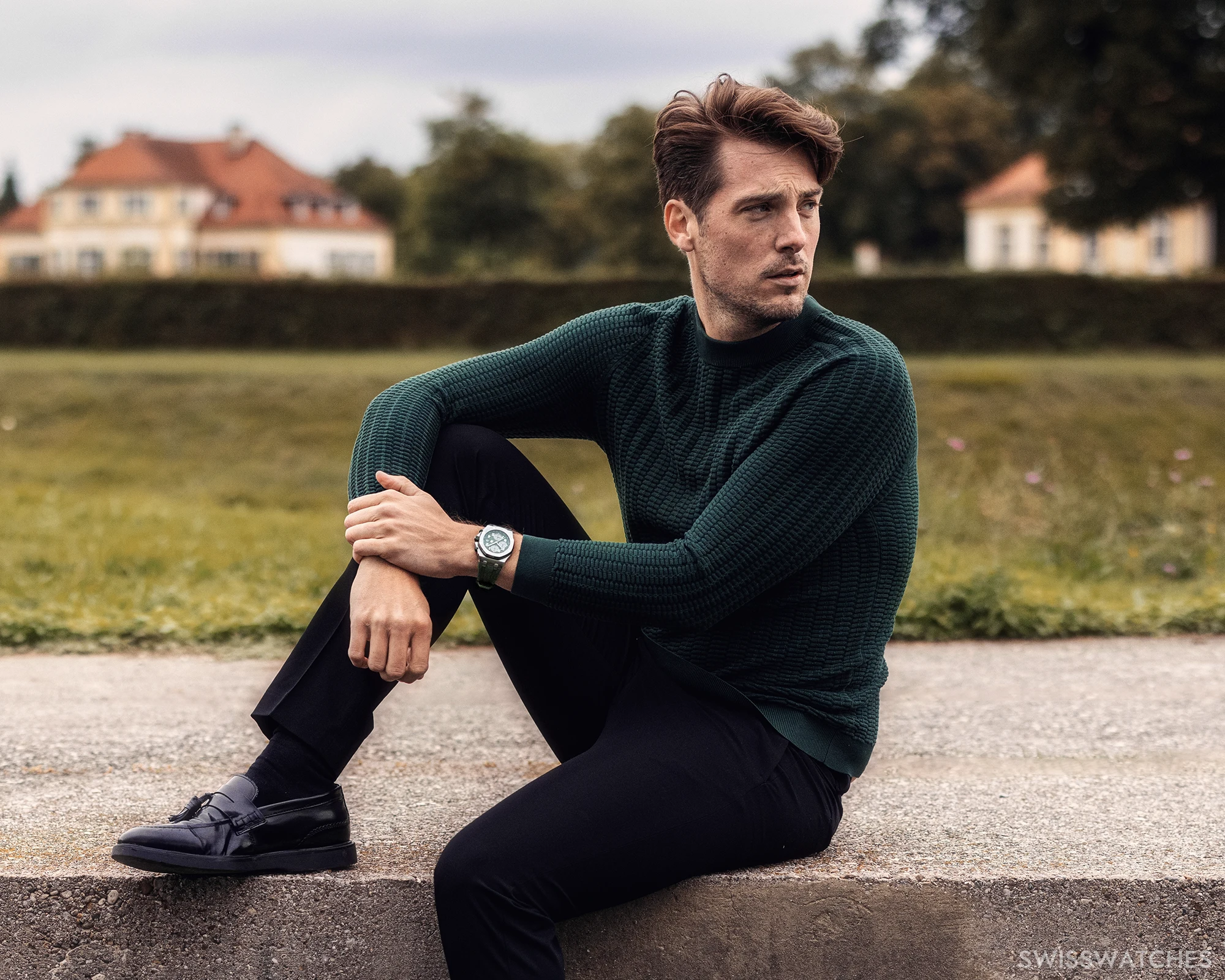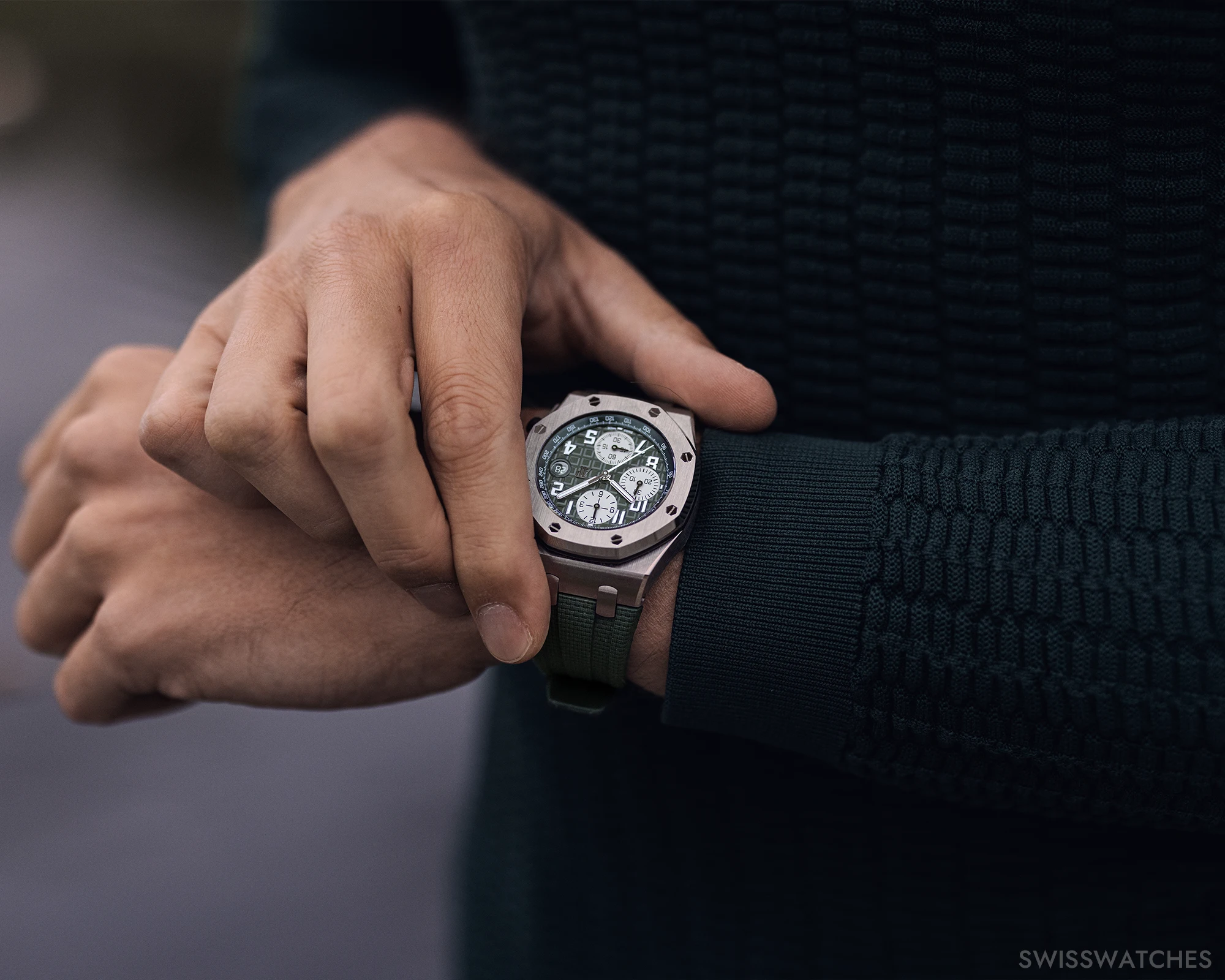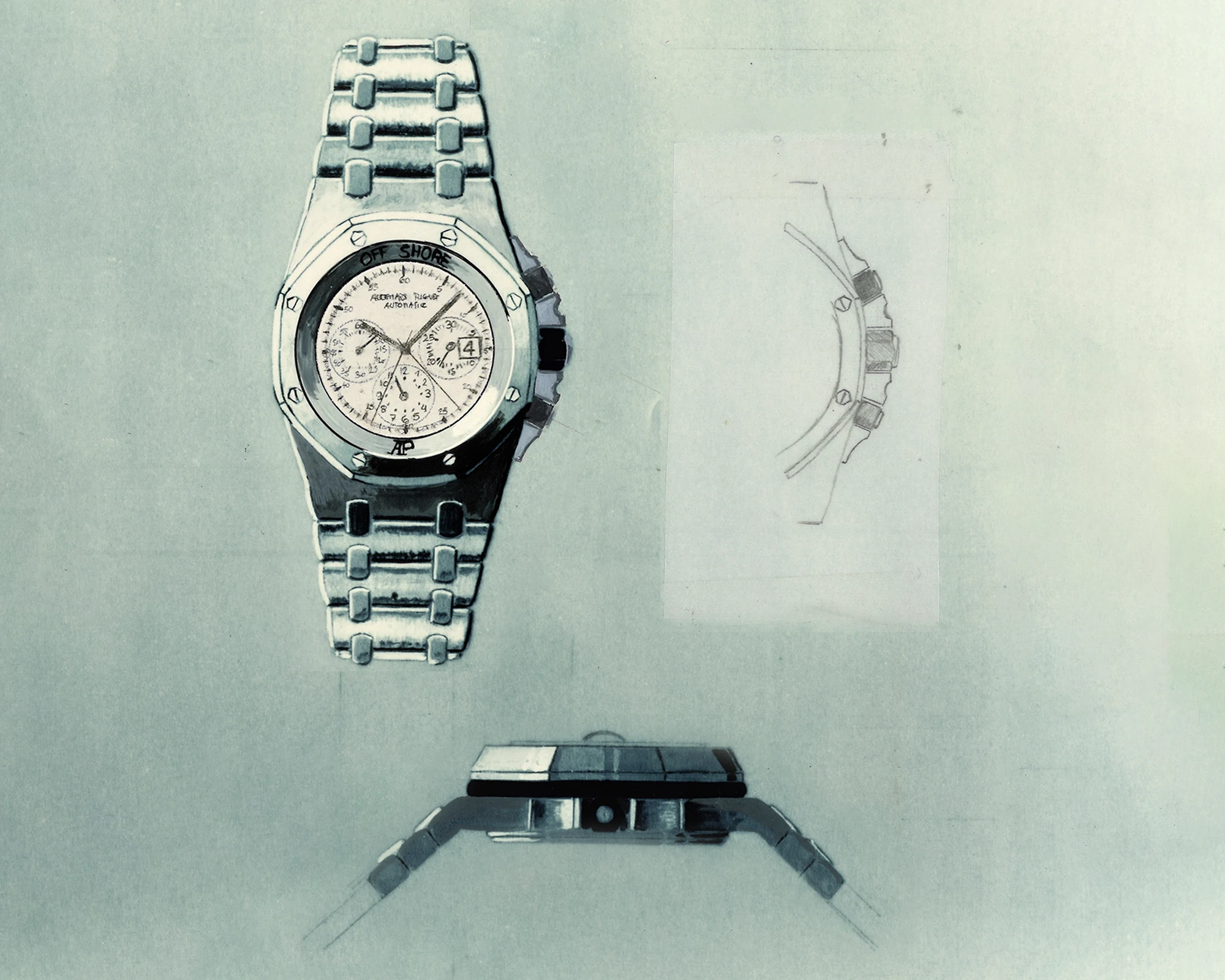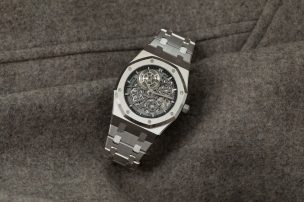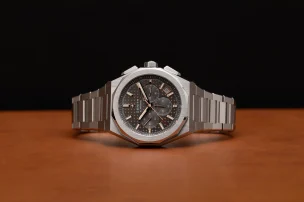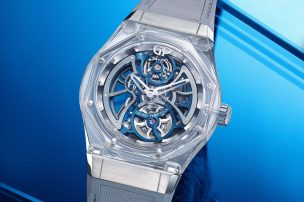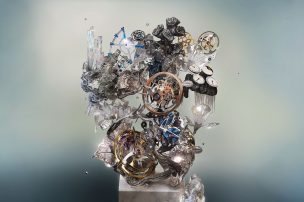
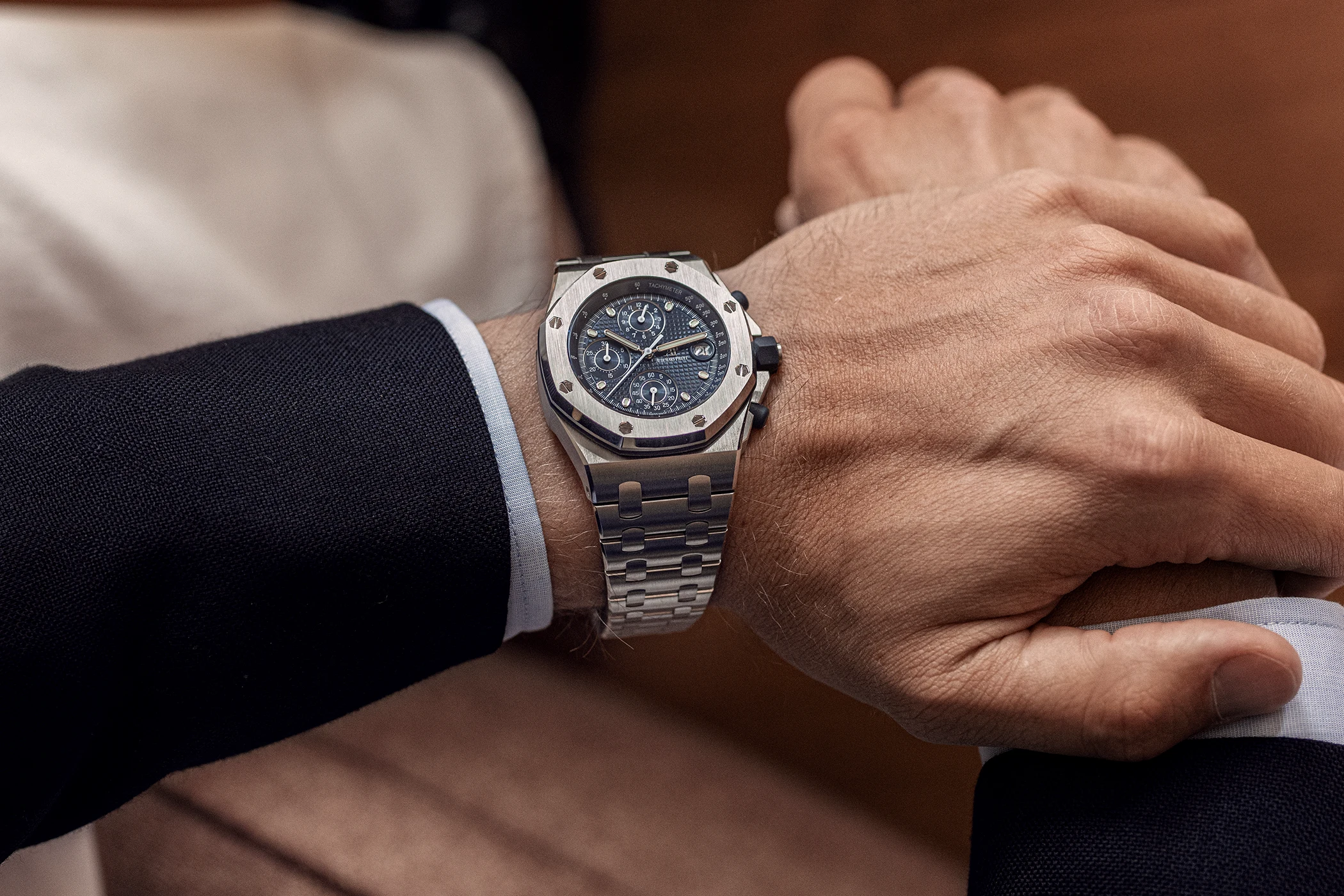
How Audemars Piguet’s Royal Oak Offshore Combined Luxury With Culture For The First Time
In this article, we delve into the world of the Royal Oak Offshore – a watch that caused heated discussions when it was launched, and simultaneously set a bold new trend at Audemars Piguet: that of larger sized watches. Hardly any other model has had such a lasting impact on the brand, turned into a playground for collaborations, and paved Audemars Piguet’s way into pop culture. But rather than just recounting its history, we’re taking a different approach this time: we take a look at the current Offshore models, before retracing the iconic references that gave the Offshore its cult status step by step.

The Royal Oak: The design that brought the Offshore to life
To understand how the Royal Oak Offshore became what it is today, it is worth taking a look at how Gérald Genta changed the world of luxury watches with the original Royal Oak, launched in 1972.
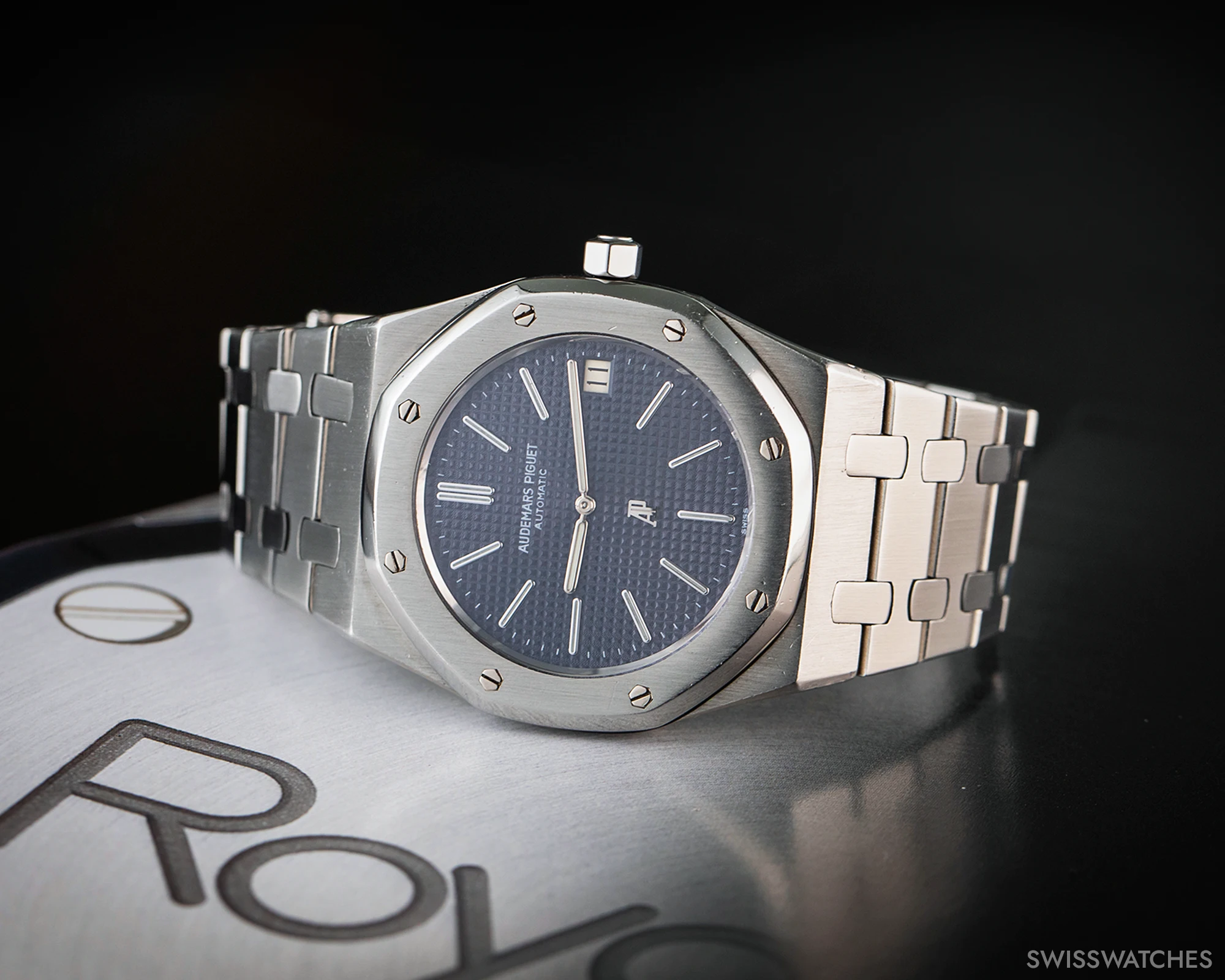
Royal Oak 5402
Described by Gérald Genta as ‘the masterpiece of his career’, the Royal Oak was famously created overnight by the designer at the request of Georges Golay, who was Audemars Piguet’s General Manager from 1966 until his death in 1987. This is how the Royal Oak gained its distinctive features: its aesthetic was characterised by the interplay of an octagonal bezel with eight hexagonal screws integrated into a monobloc tonneau-shaped case. Making its debut as the most expensive steel watch of all time, these features made the watch stand out from the crowd. Thanks to the frenzy of geometry that Genta helped Audemars Piguet achieve, coupled with the brand’s watchmaking reputation, the Royal Oak marked a turning point as ‘the world’s first luxury sports watch’.
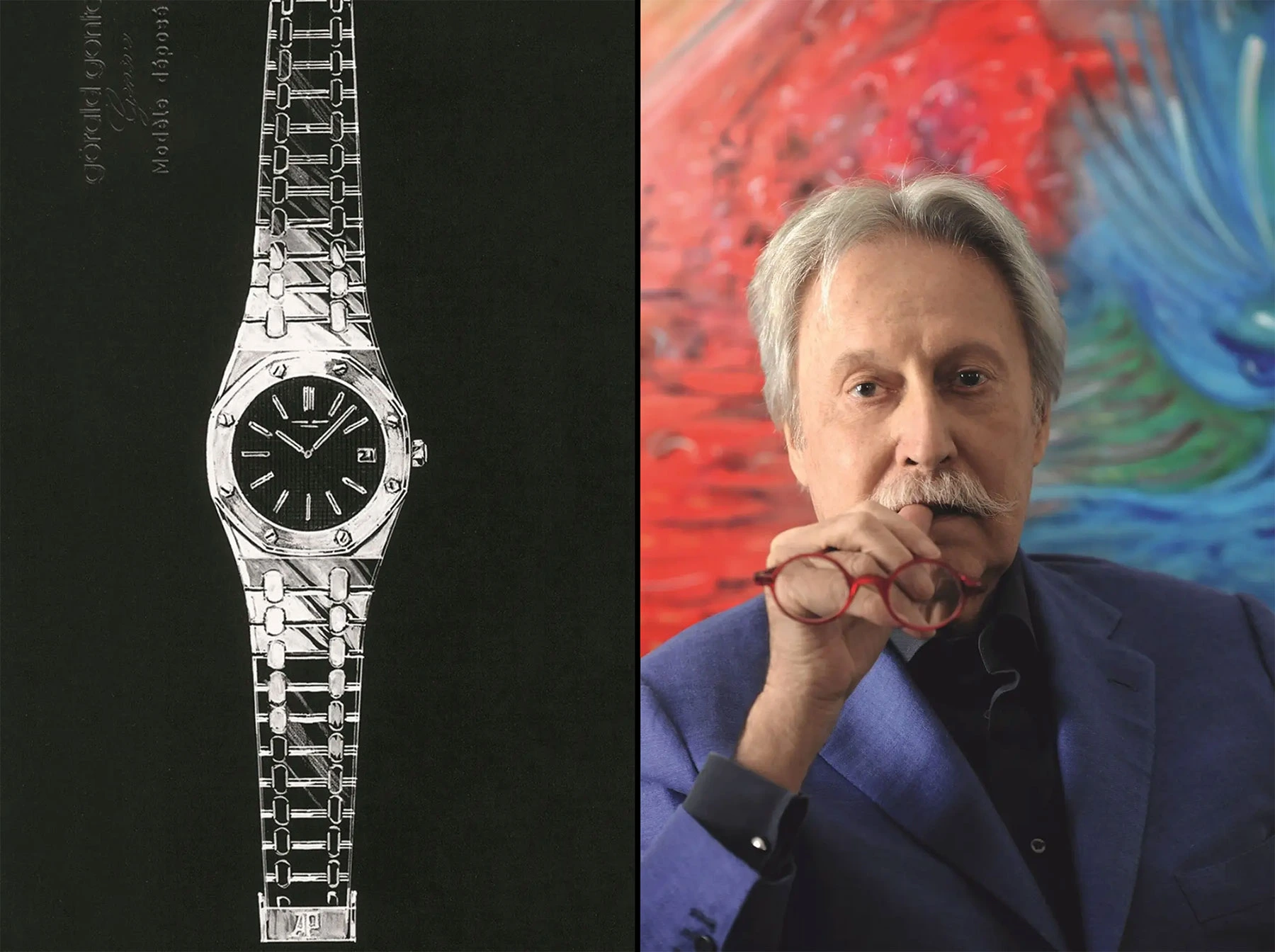
Gérald Genta’s iconic design draft for Audemars Piguet Royal Oak
For the first time in history, a timepiece combined robust functionality with the Vallée de Joux’s watchmaking prestige. Concurrently, it also laid the foundations for the luxury steel sports watch through a fully integrated bracelet. Hoping to capitalise on Genta’s flair for a balanced design and his creative energy, Patek Philippe also approached the designer, leading to Patek Philippe’s conception of the Nautilus in 1976. At a time when the cases of most luxury watches were made of precious metals such as gold, one thing became clear for the first time in watchmaking history: from now on, some of the most expensive watches in the world would be made of steel.
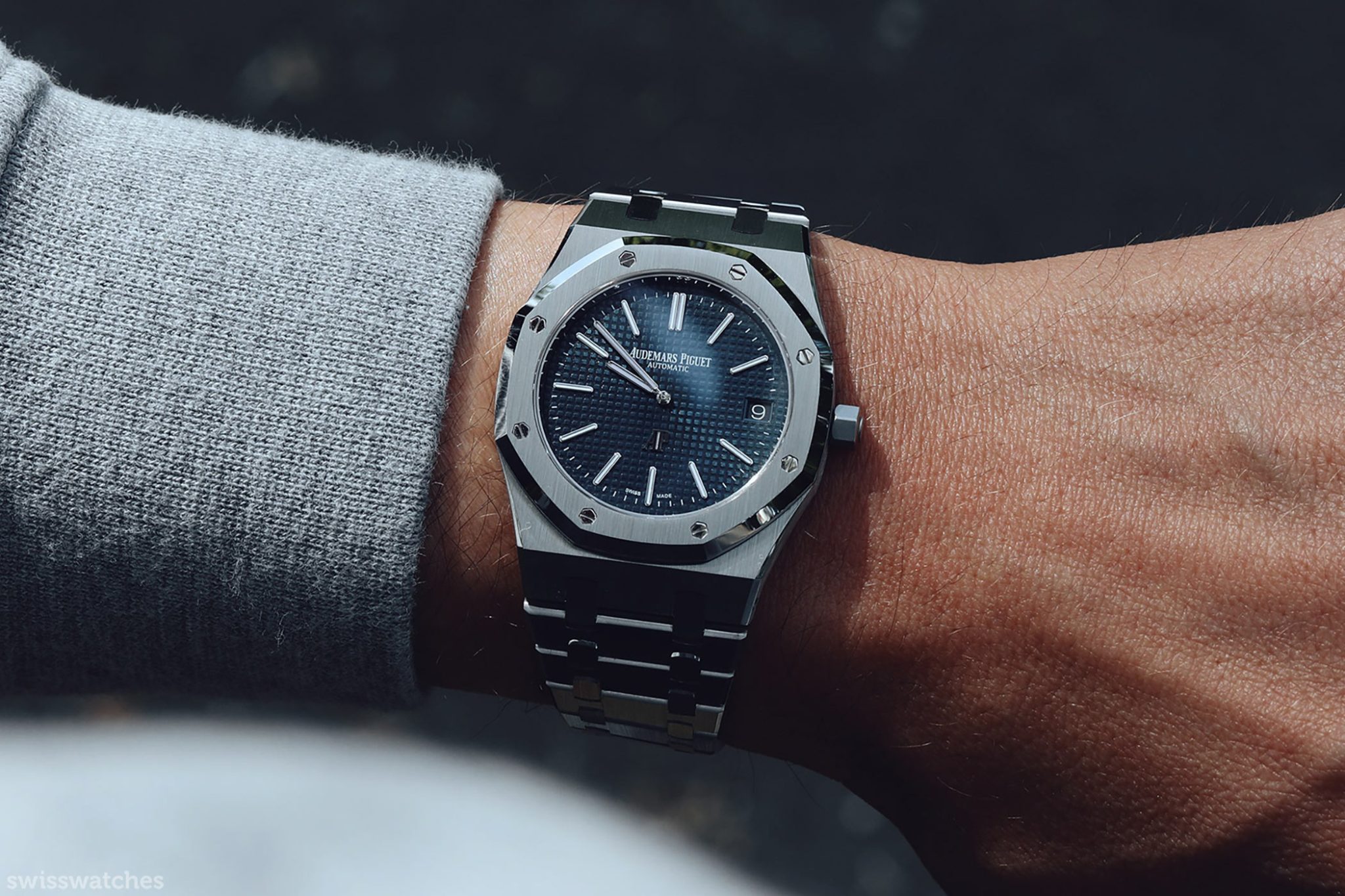
Royal Oak 15202ST
The birth of the Royal Offshore
However, the true strength of Genta’s Royal Oak, which far exceeds its innovative power and which even Genta himself could not foresee, would only become apparent in its universality and timelessness years later. In terms of design and function, the Royal Oak was not only authoritative in its own right, but also for the brand’s subsequent product lines. As a good design that fully fulfils its purpose and is aesthetically pleasing at the same time, the Royal Oak was then launched on the market in ever new variations that took up and further developed the basic concept. It was reduced in size, refined with precious metals, diamonds, and later with horological complications. By 1989, the Royal Oak family already comprised 129 different models.
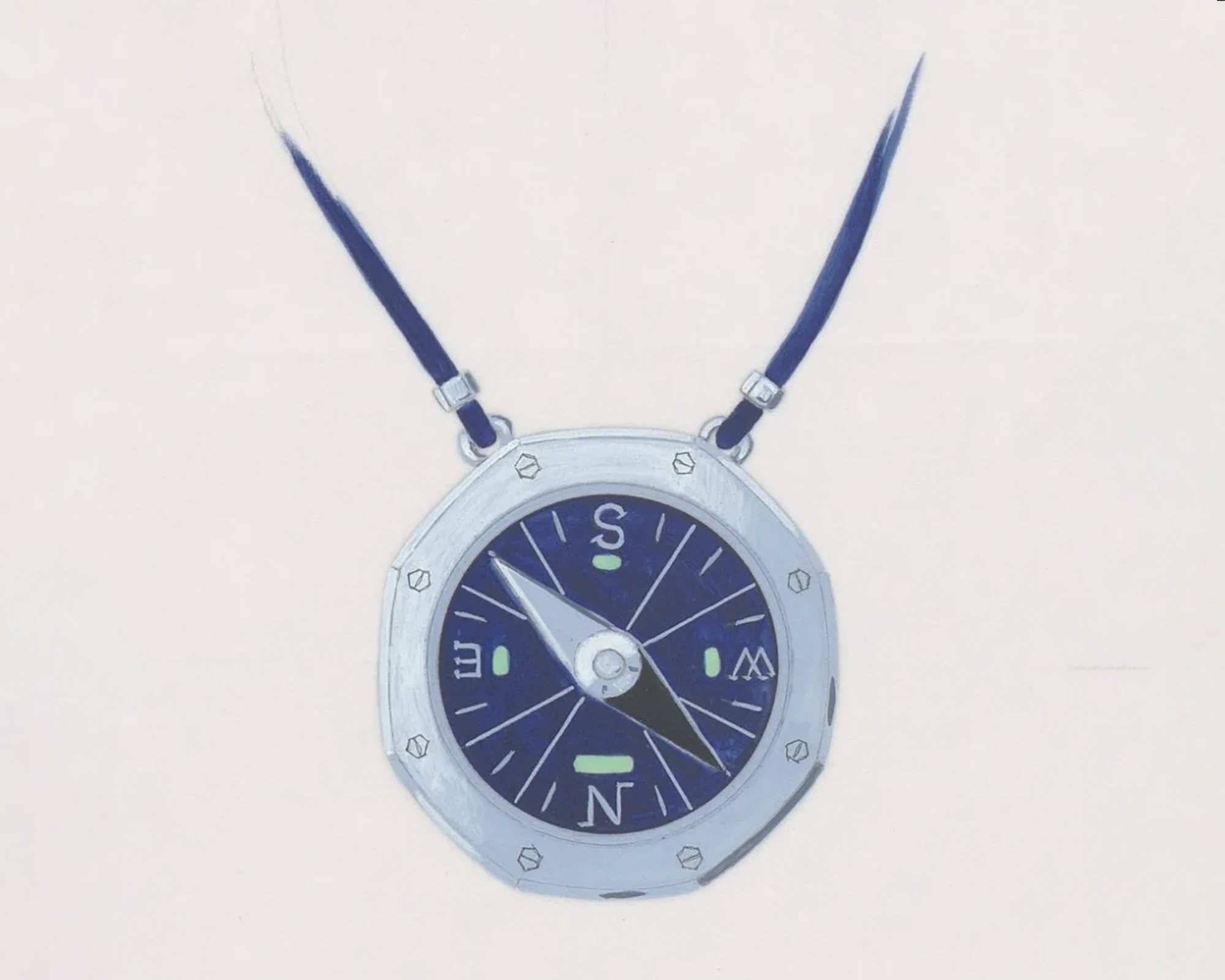
In 1991, Offshore designer Emmanuel Gueit took up the idea of combining the octagonal bezel of the Royal Oak with the functionality of a compass.
In 1993, as the Royal Oak’s sales stagnated and calls for a new model grew, the time finally came: the Royal Oak Offshore, which presented the emblematic design in an altogether more masculine guise, began life at Baselworld 1993. Essentially, the watch still fully corresponded to the original through its symbolic octagonal bezel and the integrated bracelet. However, there were some decisive differences: a solid watch with a case that had a diameter of 42 mm, a chronograph that had never before been seen in the Royal Oak collection, and an oversized bezel with an equally oversized gasket ring. The Offshore made the watch world sit up and take notice – but also, inevitably, led to a certain amount of criticism.
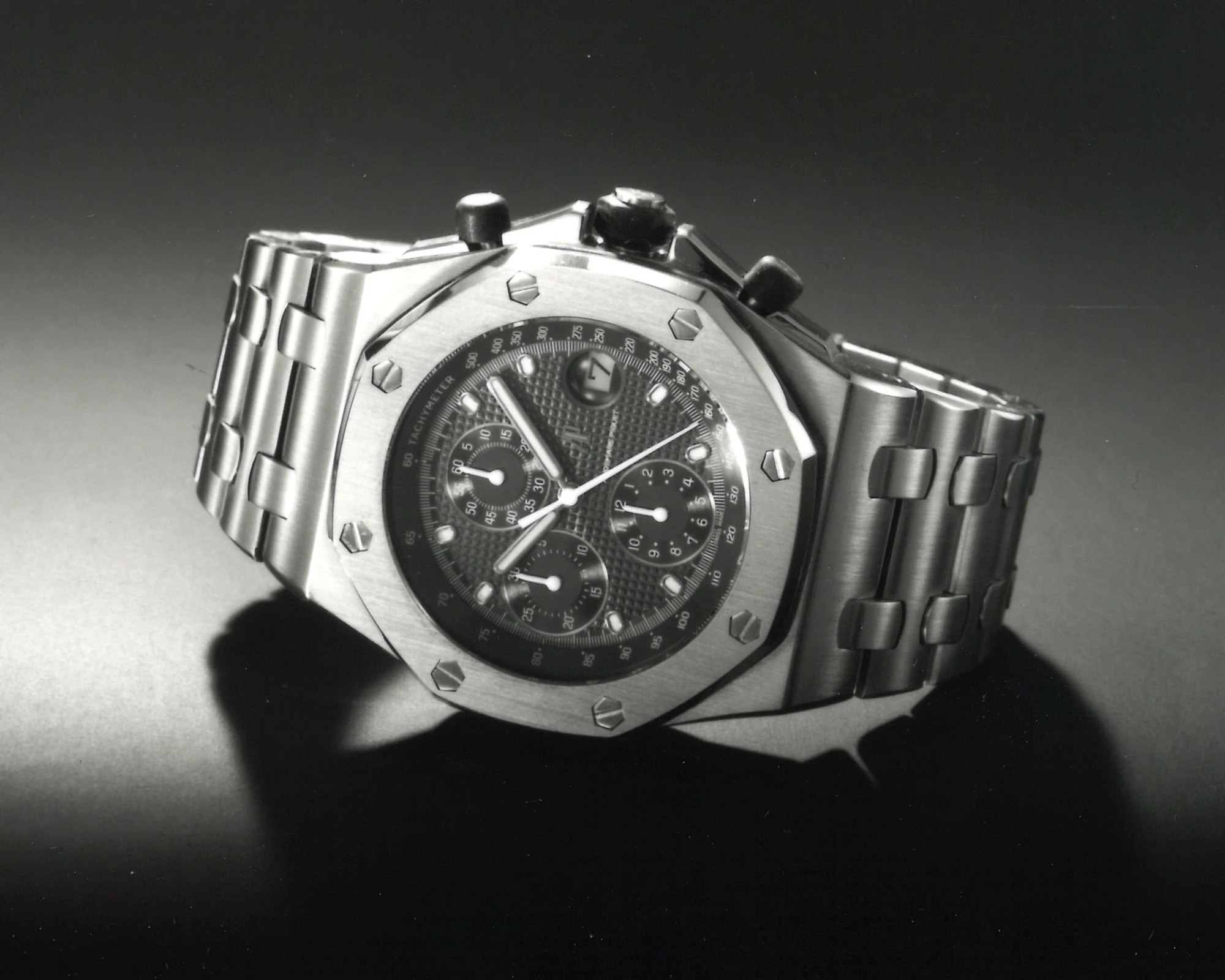
The Royal Oak Offshore was created by the young designer Emmanuel Gueit. After he was asked by the then-Audemars Piguet Co-Managing Director Stephen Urquhart, who filled this position alongside Georges Henri, he gave the Royal Oak a more masculine design. However, this did not only spark controversy within the watch scene, but also among Gérald Genta himself: wasn’t the Offshore too bulky and incompatible with the classic design of the Royal Oak in some people’s eyes? Even today, now that the Offshore has its success story, these opinions continue to be voiced in the watch scene.
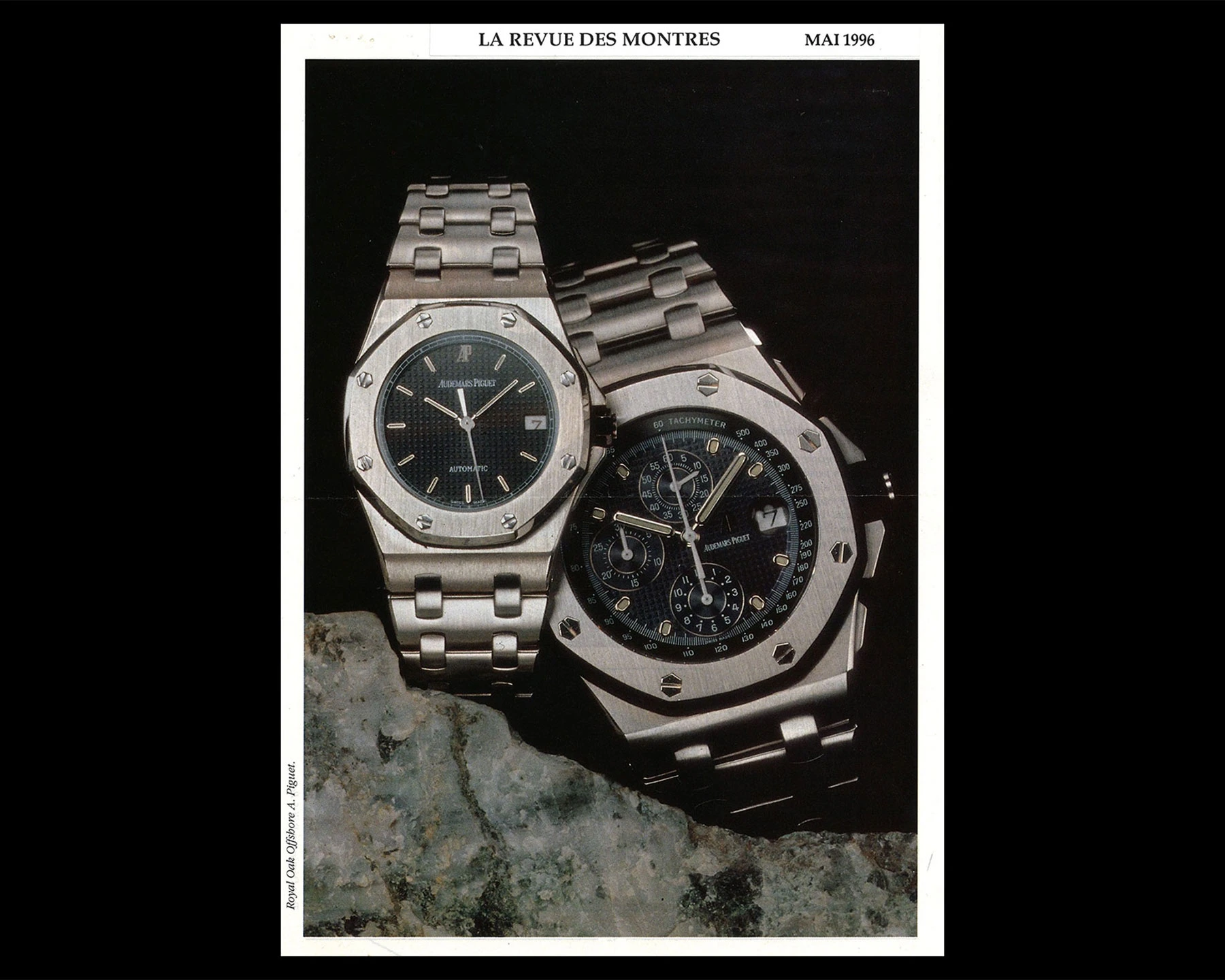
Genta, who felt that Gueit’s design had lost the essence of his original Royal Oak, even went so far as to call Gueit a ‘murderer’ for what he had done with his design. In truth, however, Gueit left nothing to chance. Rather, he gave the Royal Oak Offshore a more masculine quality through its visual impact, which, with its overall effect, aroused the curiosity of the model’s target audience: a young and male target group. Today, the Offshore still embodies this interplay of tradition and innovation. But what does the Royal Oak Offshore look like today? Let’s take a look at the current models, to discover how Audemars Piguet has technically and aesthetically developed the collection without losing its original DNA.
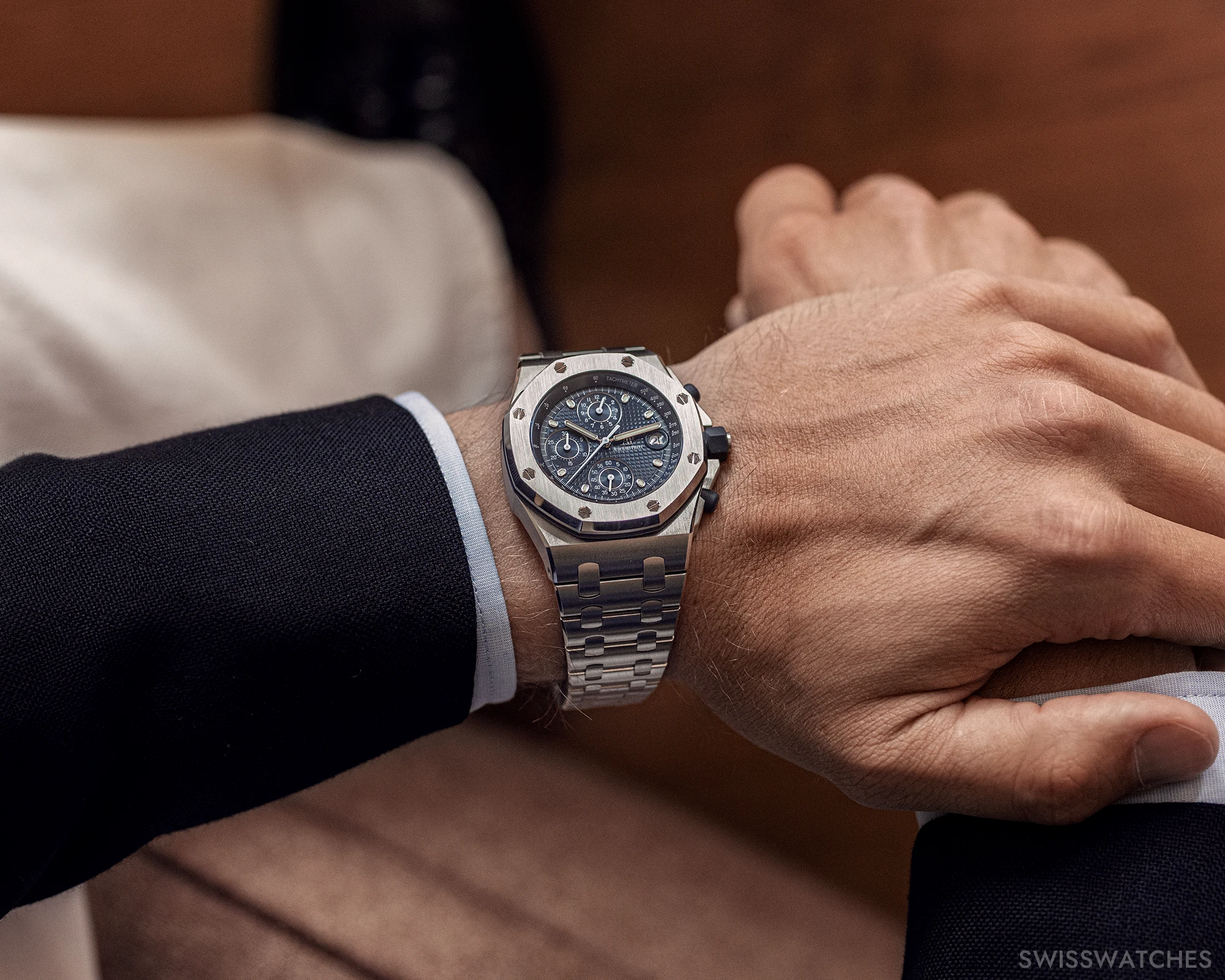
The Royal Oak Offshore today
2021: Royal Oak Offshore Chronograph Automatic 26238TI.OO.2000TI.01
In 2021, the brand launched a further development of the Offshore from 1993. It appeared in stainless steel, alongside two new case versions in titanium and 18-carat rose gold. The first Offshore made entirely of titanium (Ref. 25721TI) had already been launched in 2004. However, the reinterpretation of the 1993 timepiece in 18-carat rose gold (Ref. 26238OR.OO.2000OR.01) was an absolute novelty for the brand. The case and bracelet of the three timepieces were finished entirely by hand with alternating satin-finished and polished edges, while rubber pushers and crowns completed the look. This series also saw the introduction of the interchangeable bracelet system, which was also used for the first time on metal bracelets and allows for easy replacement.
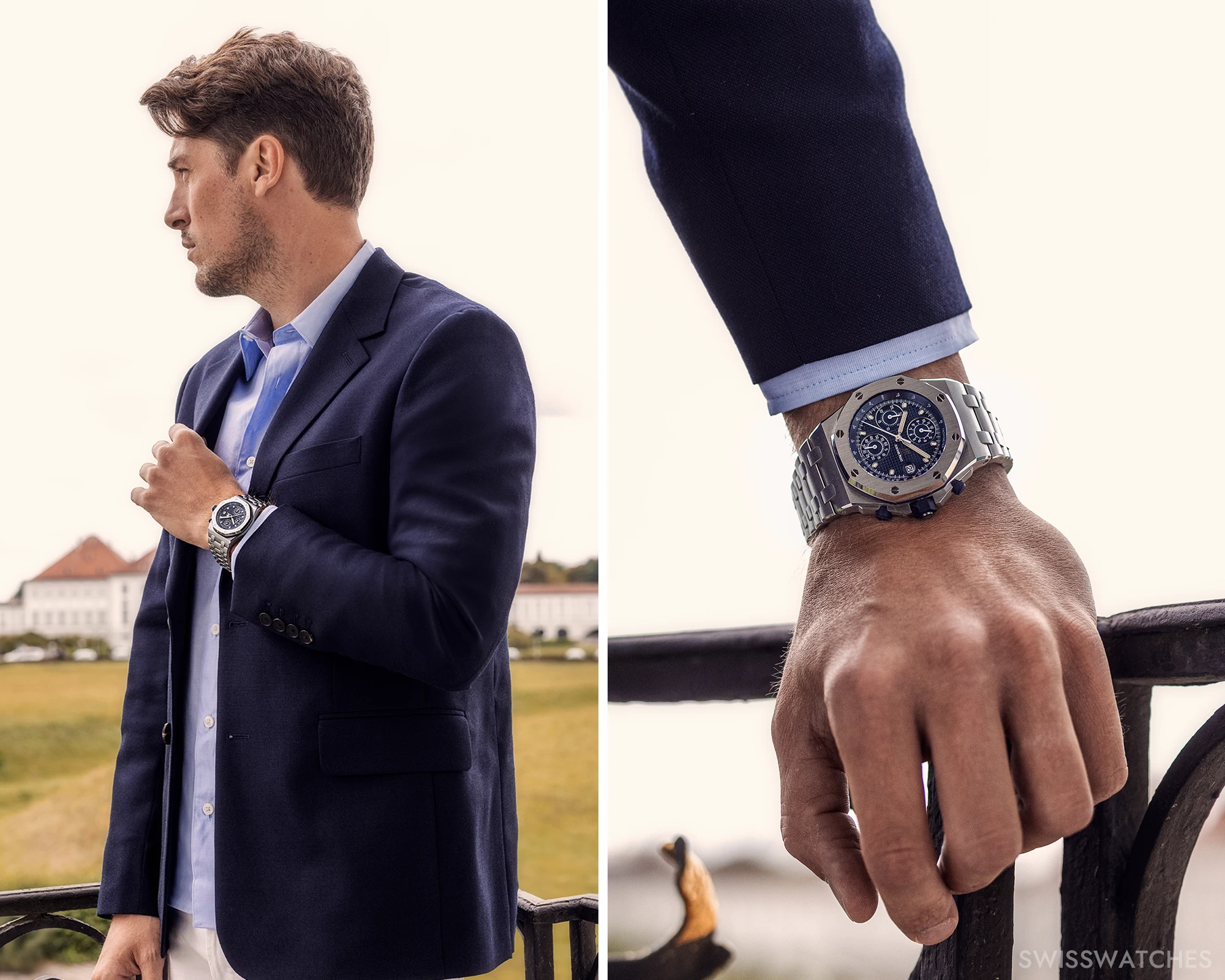
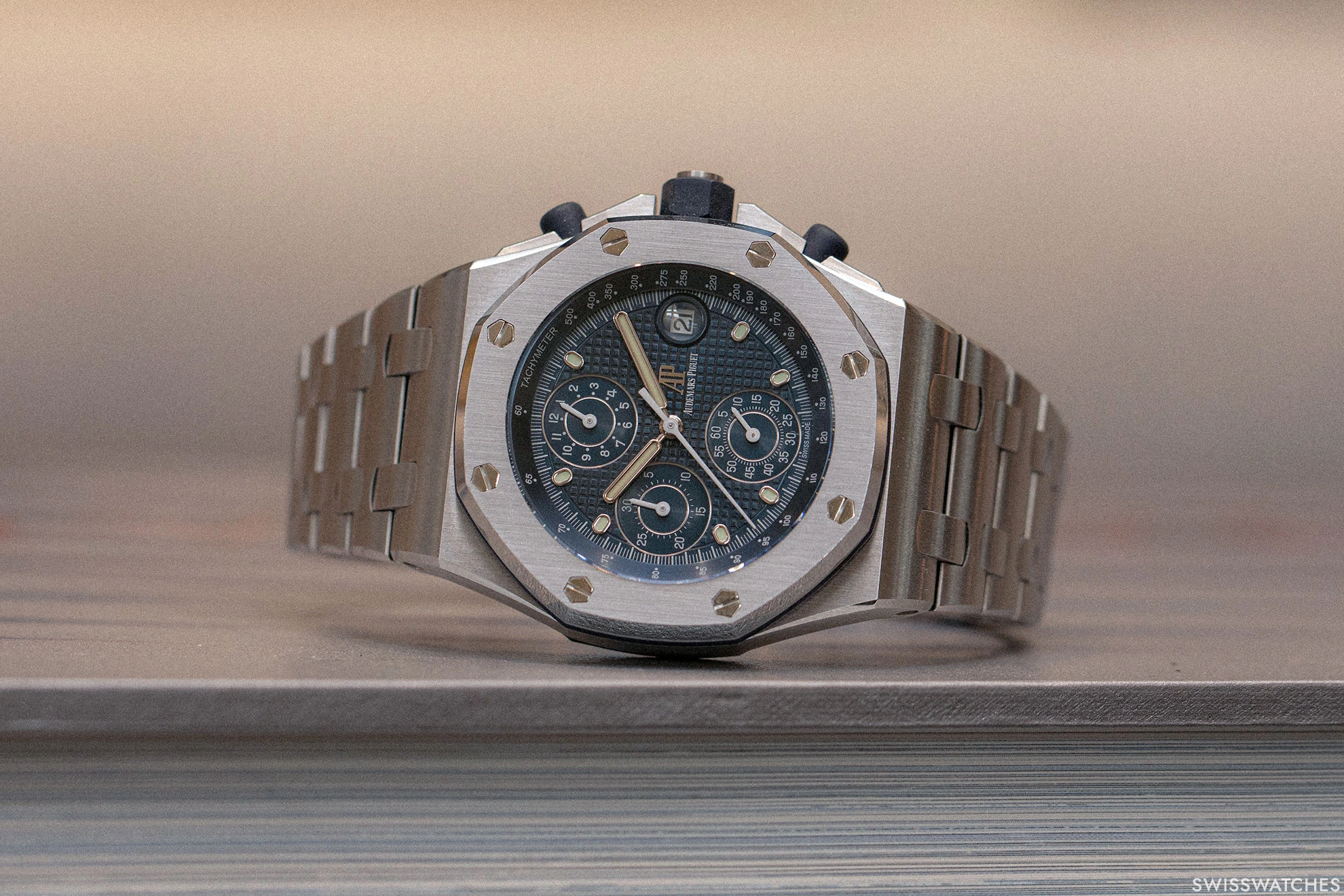
The new models also featured a ‘Petite-Tapisserie’ dial, which had already adorned the original Royal Oak but had been replaced by the ‘Méga-Tapisserie’ in 2008. It was only on the occasion of the Royal Oak’s 20th anniversary in 2013 that the ‘Petite-Tapisserie’ celebrated its comeback in the collection with the limited edition of 20 pieces (Ref. 26218), which was finalised with the Offshore on the occasion of its 25th anniversary in 2018. Inside the reinterpretation is the in-house calibre 4404, which is based on the calibre 4401 that is also used in the new Royal Oak Offshore Chronographs – more on this in a moment. The difference lies in the arrangement of the subdial counters, which can be found at 12 and 9 o’clock.
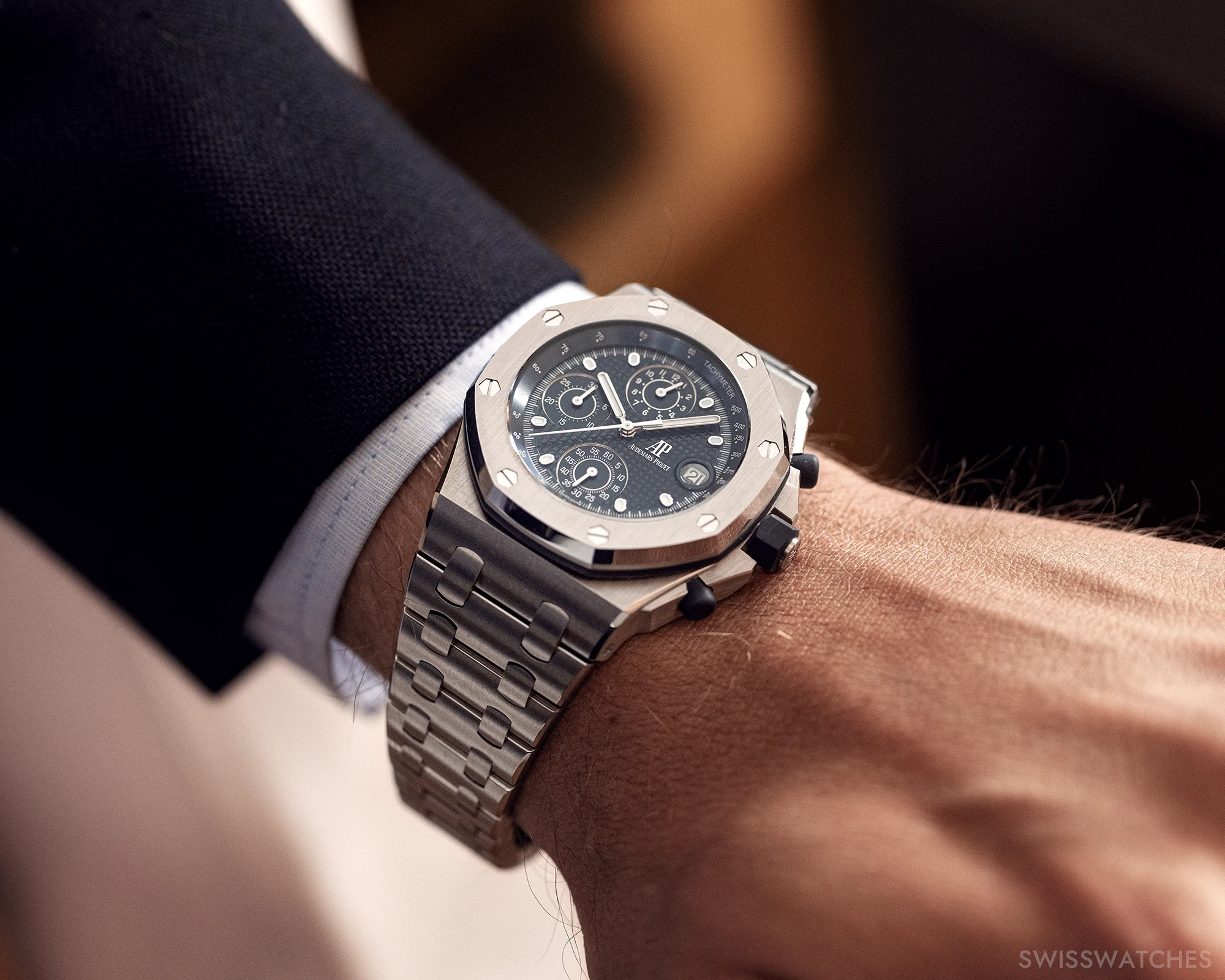
2021: Royal Oak Offshore Chronograph Automatic 26238TI.OO.A056CA.01
Also in 2021, two new Royal Oak Offshore Chronograph versions – in titanium or stainless steel – followed. They featured the automatic calibre 4404, the latest movement with an integrated flyback chronograph at the time. The movement’s flyback function allows the chronograph to be stopped, reset, and immediately restarted.
Both models are characterised by their dial in a particularly alluring design: the stainless steel model showcases a light blue ‘Méga Tapisserie’ dial, while the titanium version comes in a khaki colour. High-quality finishes such as Côtes de Genève and a 22-carat rose gold oscillating weight, which is visible through the open sapphire crystal caseback, round off the design.
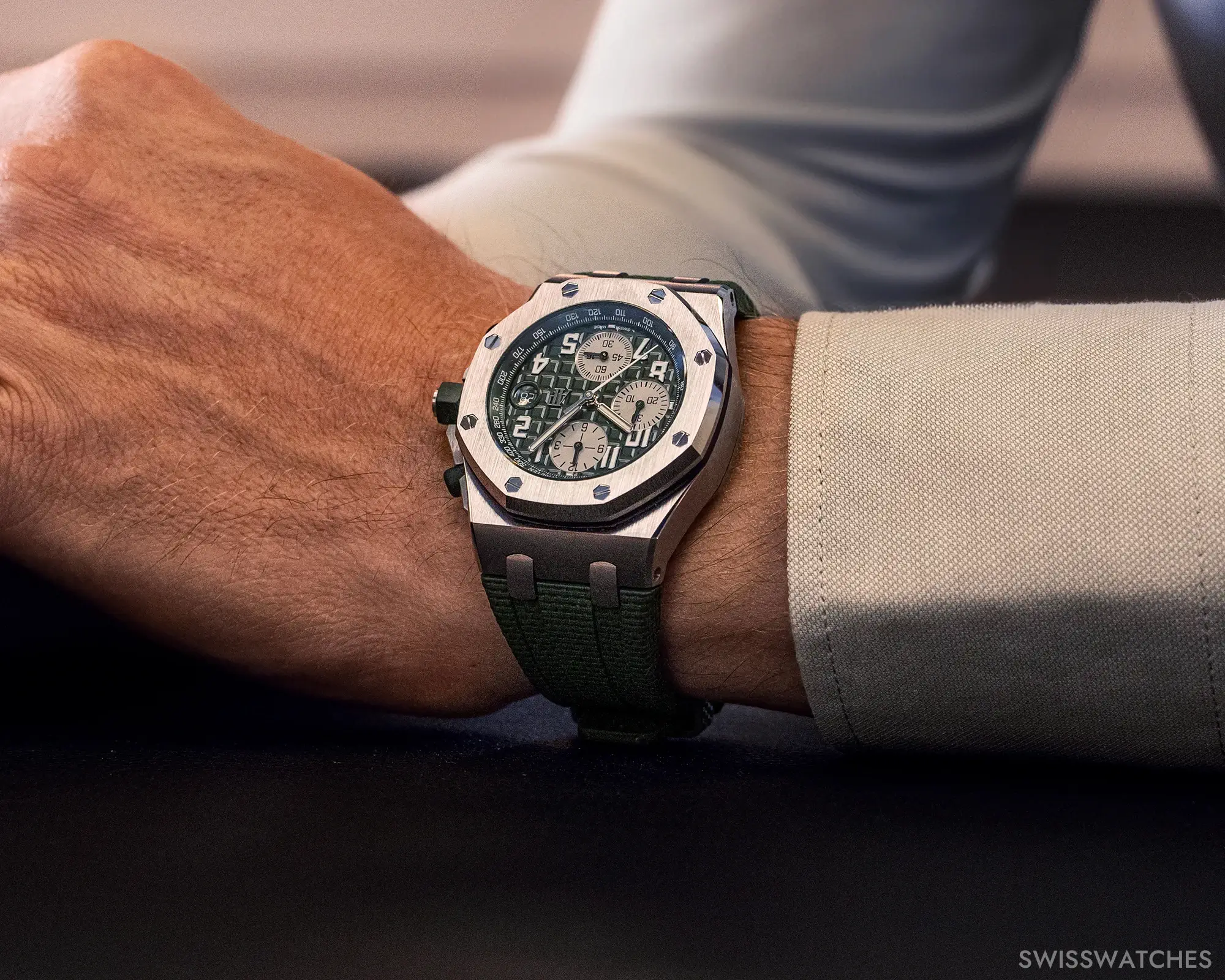


2024: Royal Oak Offshore Chronograph Automatic Ref. 26420ST.OO.A828CR.01
The first 2024 novelty with a flyback chronograph function presents itself with a ‘Méga Tapisserie’ dial. Still a central design feature of the Offshore collection, its patterns and textures have been modernised to create more depth. Each tile features vertical stripes and is connected by an ‘X’ shaped symbol. In addition, a colour transition on the fumé dial, whose light brown hue finally merges into the black rehaut with a tachymeter scale, creates a sophisticated aesthetic. The beating heart of the watch is the brand’s latest integrated chronograph, the automatic calibre 4401, which has a power reserve of 70 hours.
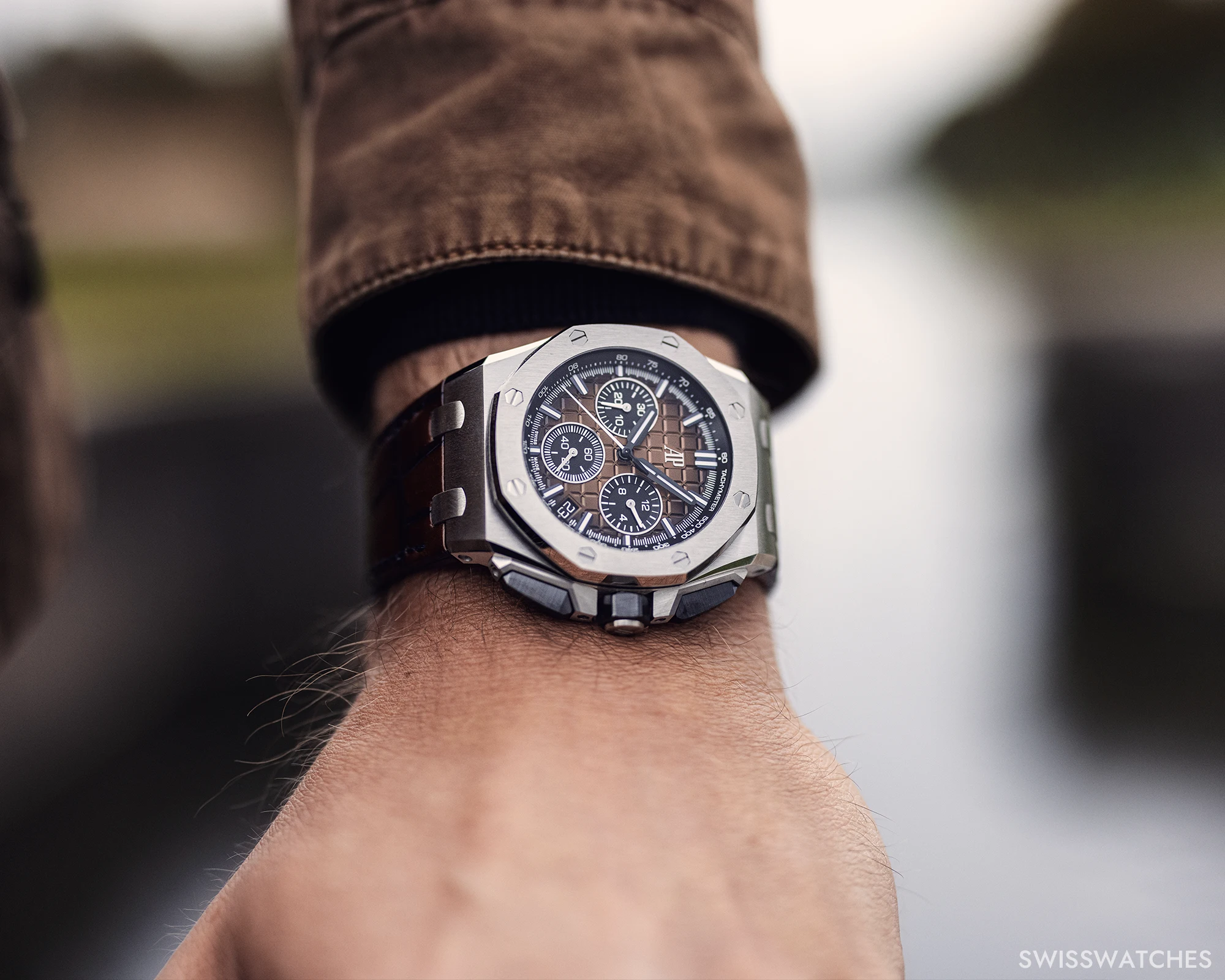
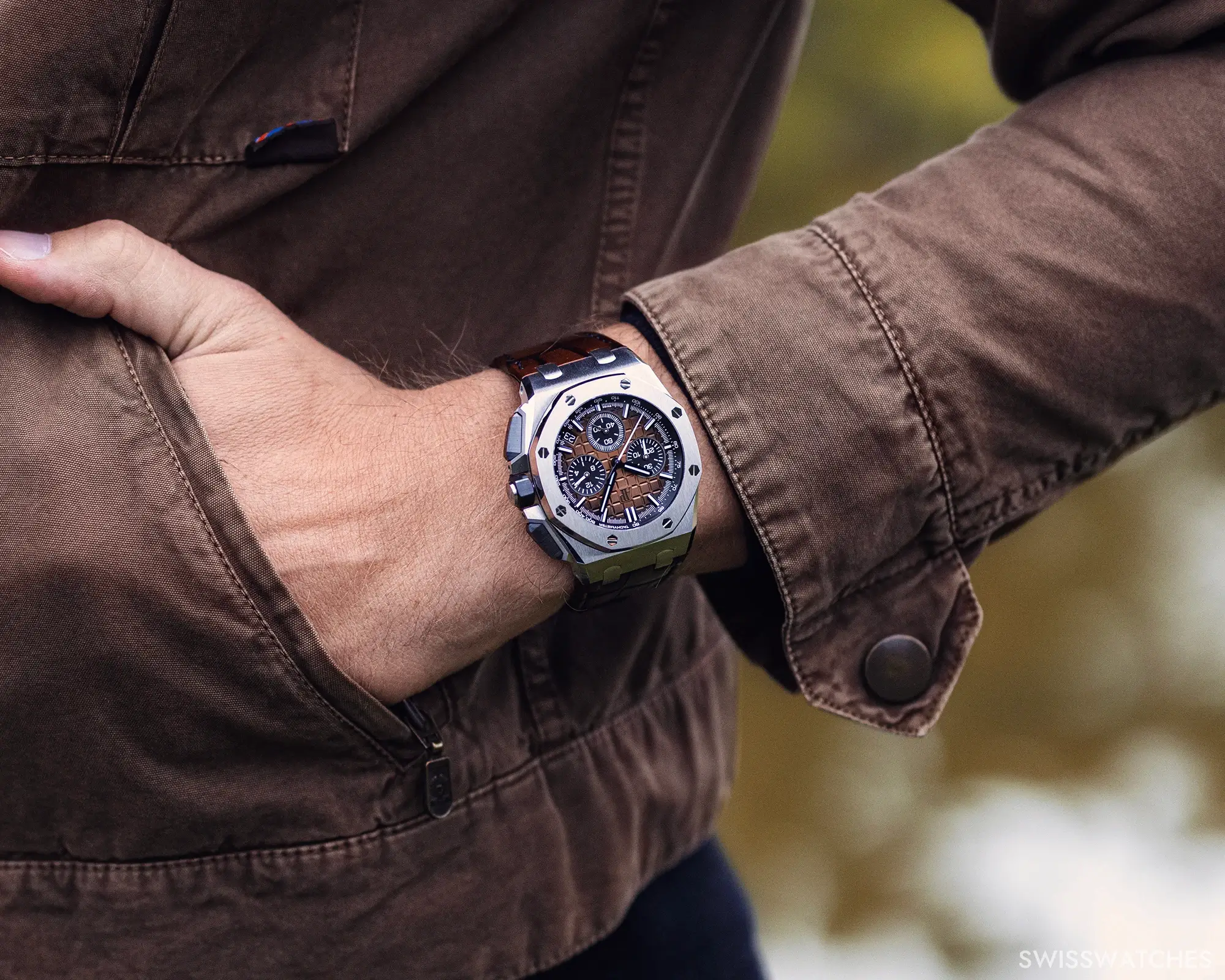

2024: Royal Oak Offshore Automatic 15605SK.OO.A350CA.01
This year’s second novelty is characterised by the combination of a stainless steel case with an octagonal steel bezel covered in rubber and a matching rubber strap in blue. The groundwork for this model was laid by the reference 25940SK, launched in 2001. Through its ‘Méga tapisserie’ dial and above all through its first-time use of a rubber bezel and a rubber strap, it was a design that few people at the time could comprehend.
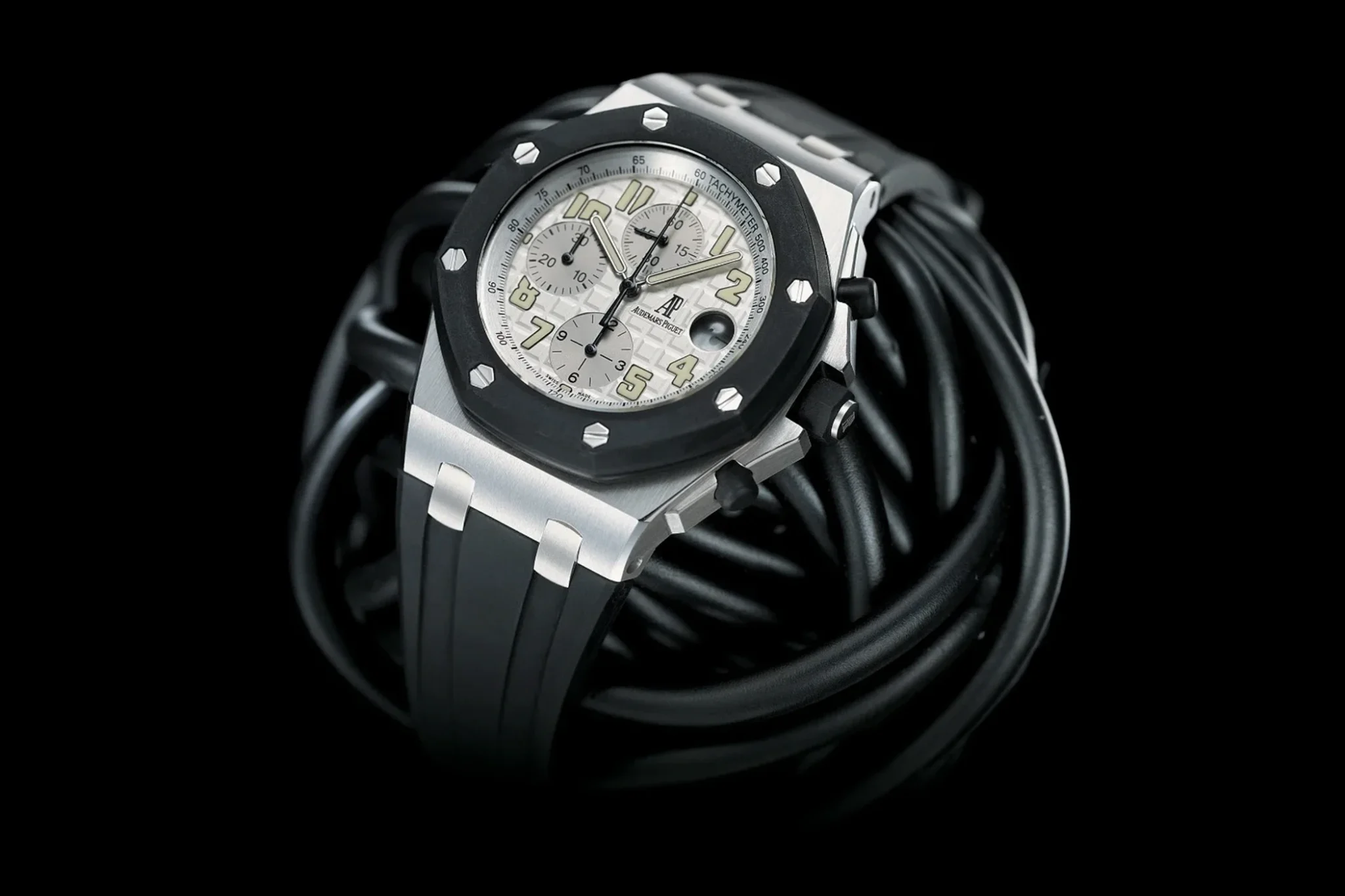
The blue aesthetic continues on the blue dial, which is the centrepiece of this watch with three hands and a date display. The trapezoidal hour markers and the Royal Oak hands in rhodium-plated gold with luminous material are accompanied by a blue inner bezel and the AP monogram in polished, rhodium-plated gold at 12 o’clock. From high-quality materials to innovative calibres, the modern models show how the original concept can be adapted to current trends. To understand how this development took place, let’s take a closer look at the pioneering models that gave the Offshore its cult status and laid the foundations for its current influential role in the watch world.
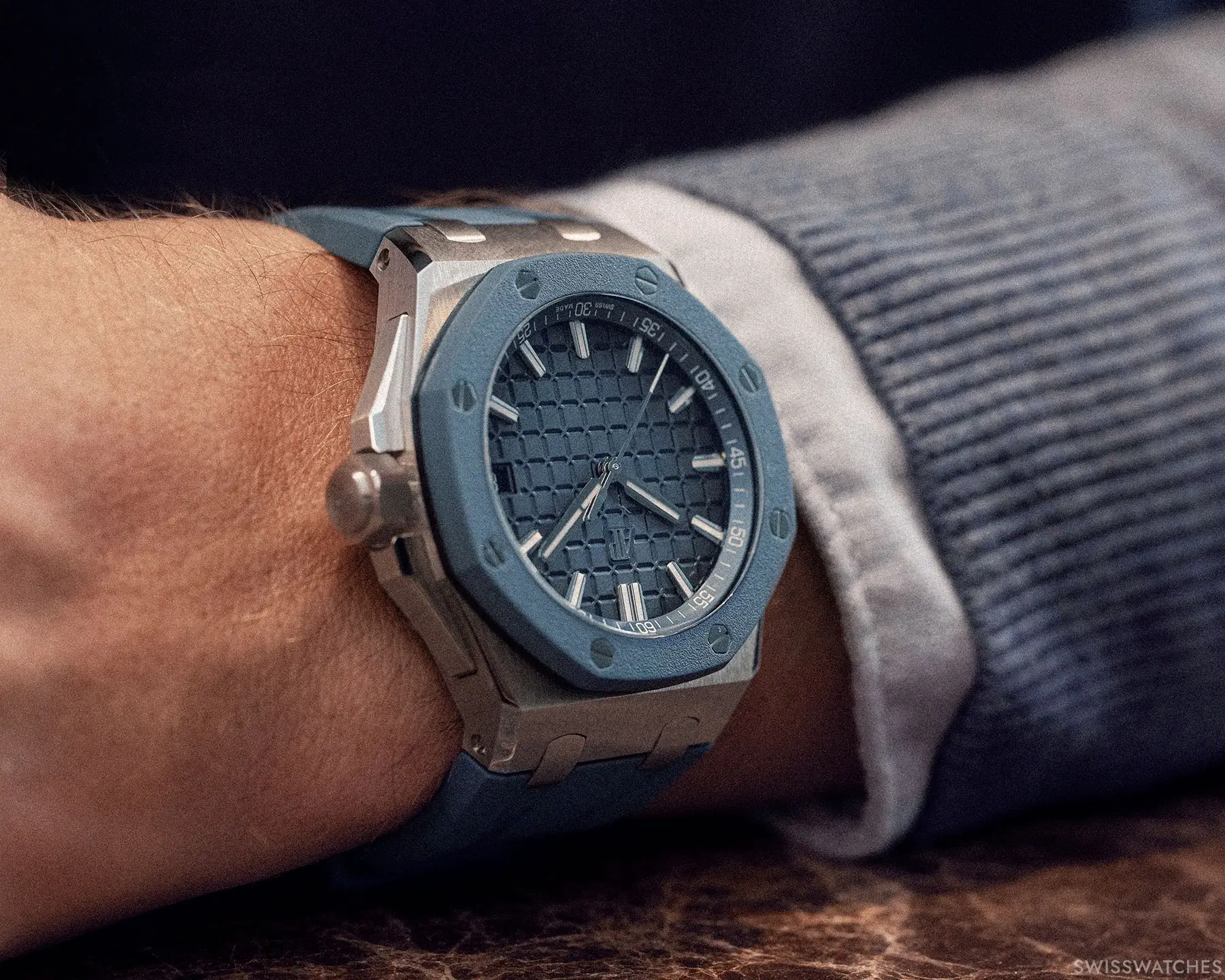
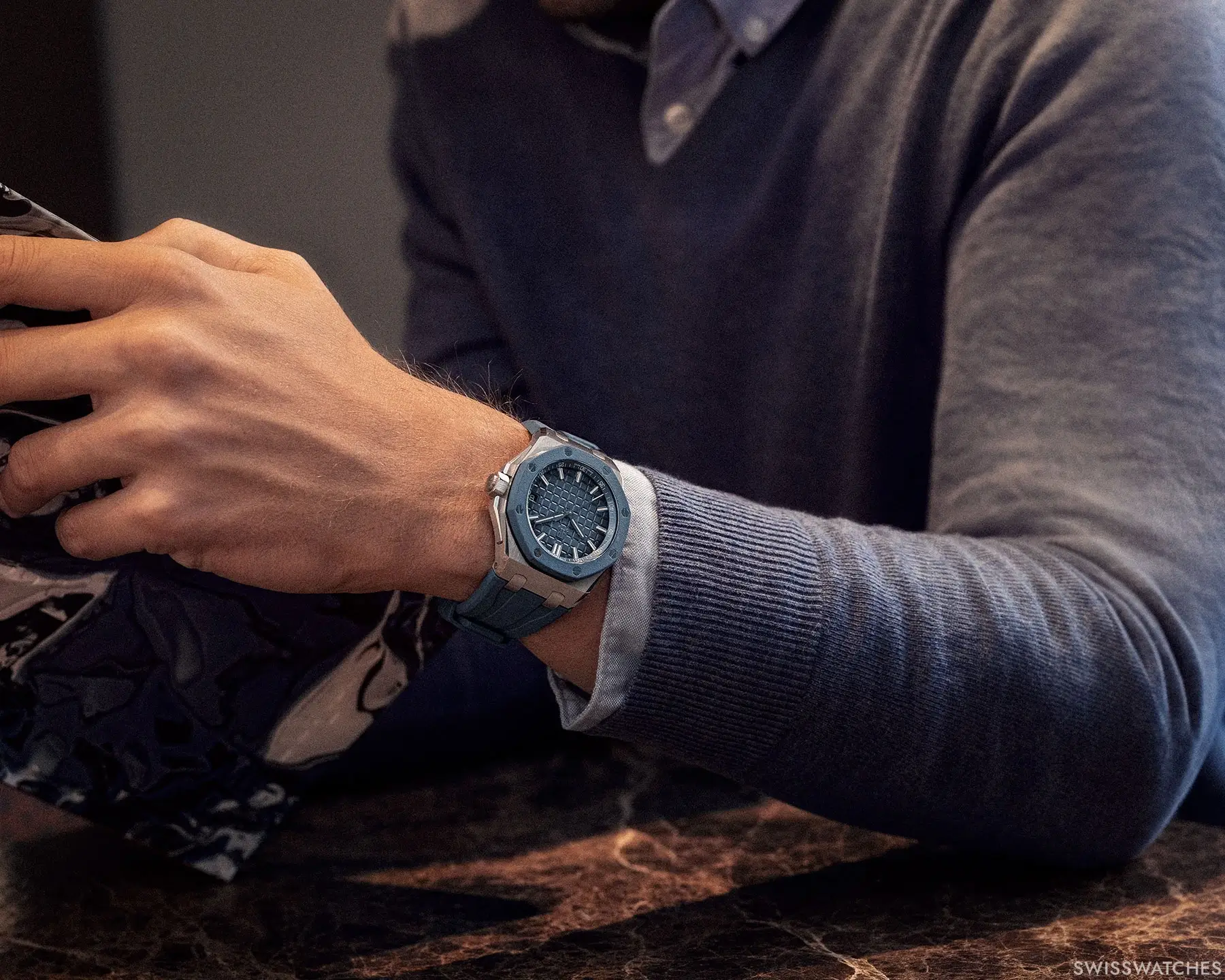
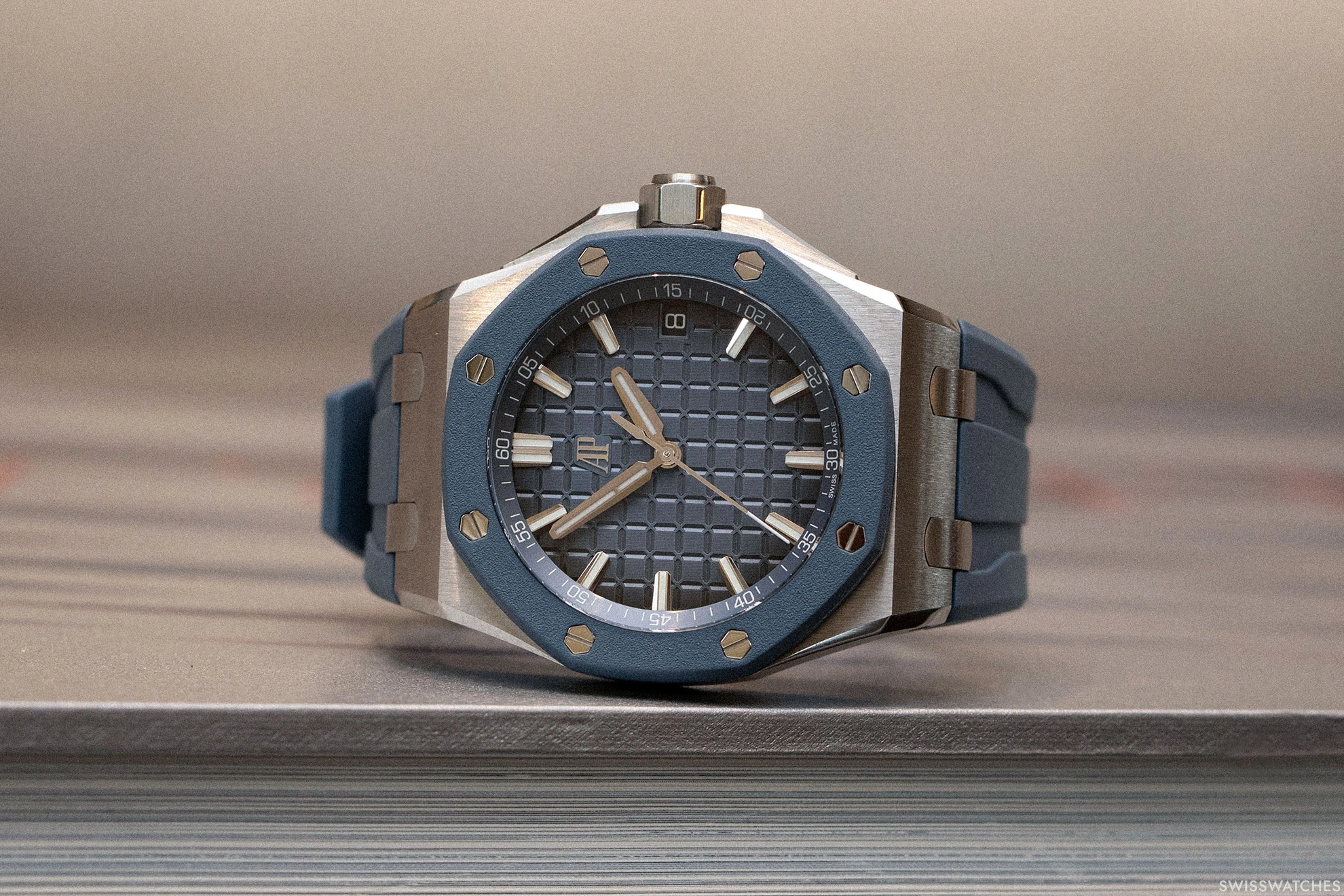
Key Offshore models
1993: Royal Oak Offshore Ref. 25721ST
It was a time of change for Audemars Piguet. The 20th anniversary of the Royal Oak was approaching, and the trend towards more masculine watches was on the rise. For the then-Co-Managing Director Stephen ‘Steve’ Urquhart, who was responsible for the collections among other things, one thing was clear: a Royal Oak had to be created that could simultaneously cater to this trend, celebrate the anniversary, and be appealing to young men. An idea that Urquhart first brought up in an internal memo dated 2 February 1989 was to provide a solution. In this memo, he referred to the idea of a certain Dierk Wettengel to create a ‘flagship product for the 1990s’, which was to be inspired by the ‘Cigarette/Offshore’ idea. Dierk Wettengel, who managed the brand’s German business and played a key role in opening up the market, was referencing the Cigarette boats – a 1980s-symbol for glamour, adventure, and a lifestyle characterised by freedom and speed – both on the water and in life.
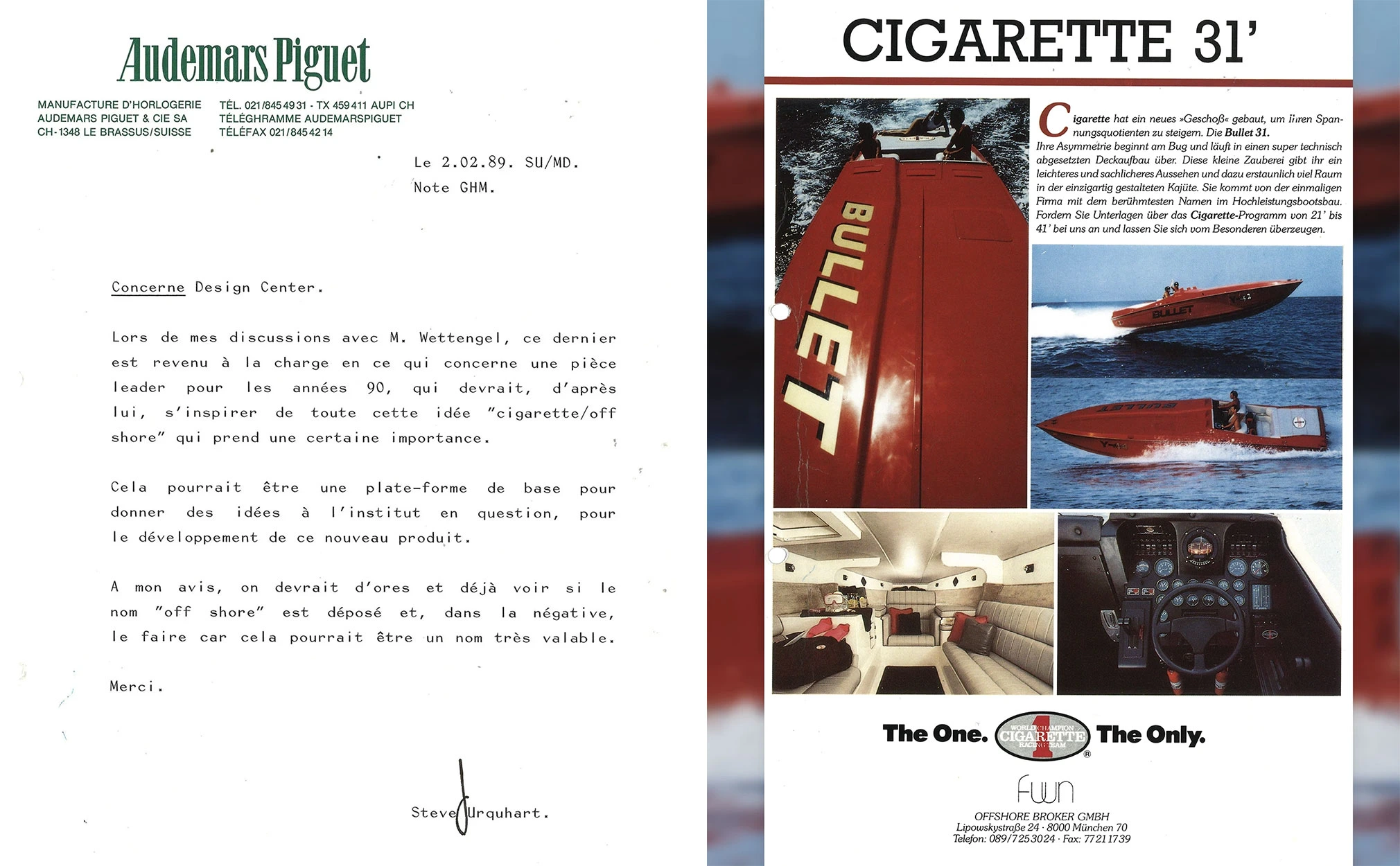
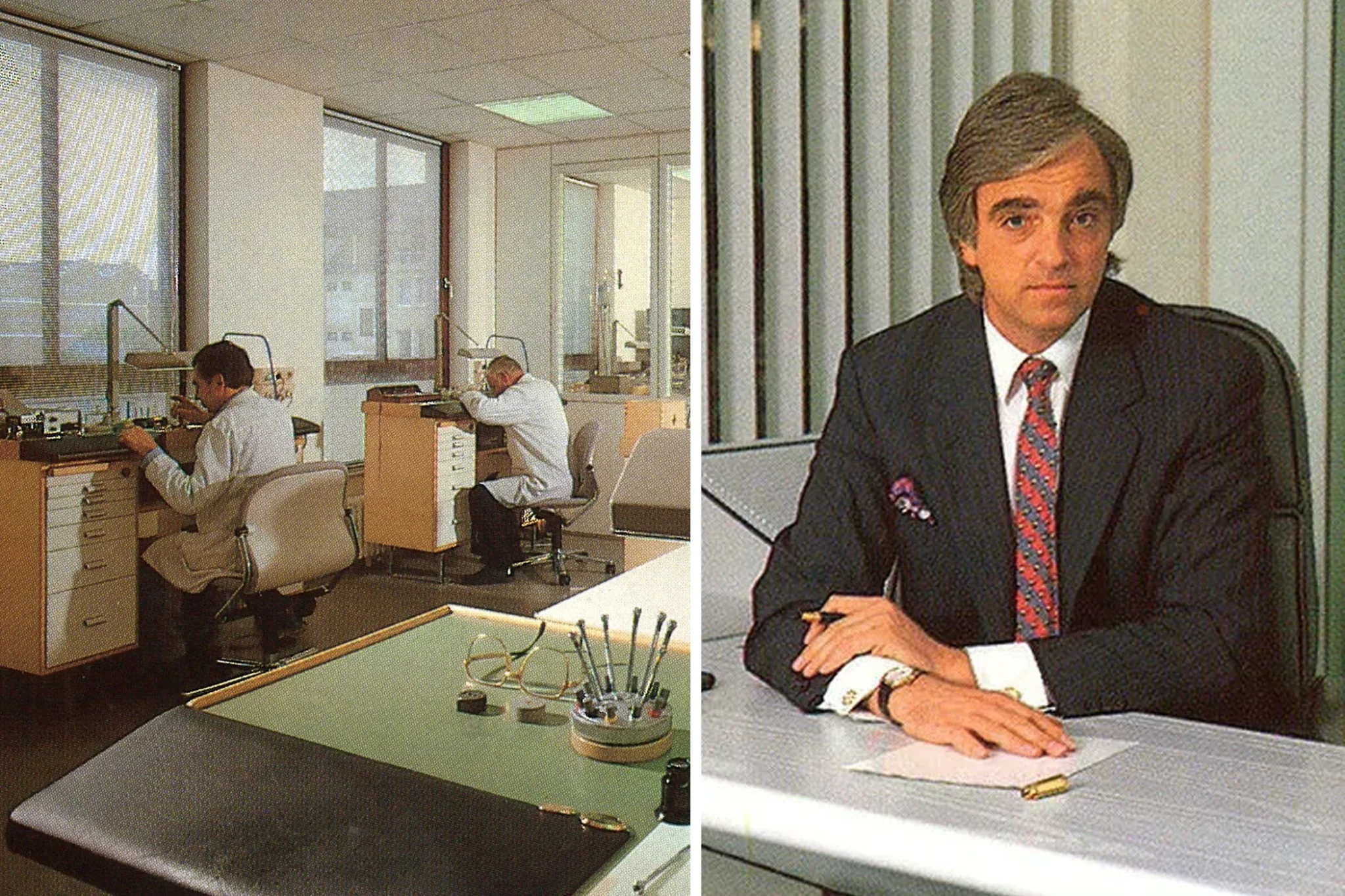
As a result, Stephen Urquhart commissioned the 22-year-old young designer Emmanuel Gueit, who finally got to work and presented his plans for the Royal Oak Offshore. But the Offshore’s time had not yet come, and as we know today, the watch’s debut was more than rocky. Fearing that the watch would be too bold and brash, the Offshore divided opinion, and not just among Audemars Piguet’s management. At that time, the largest Royal Oak for men had a diameter of only 36 mm and a thickness of 7.7 mm (Ref. 14700). In addition, complications in the production process delayed the launch of the watch until a year after the Royal Oak’s 20th anniversary in 1992, meaning that the watch could not be released as originally planned.
Offshore designer Emmanuel Gueit and the first sketches of the Offshore with a chronograph
But in 1993, the time had come: a watch with a diameter of 42 mm, a 16 mm thick stainless steel case, a triple chronograph – a complication that had previously not been featured in the Royal Oak family – and a pronounced gasket ring located under the bezel saw the light of day. ‘The Beast’, as the first reference was henceforth known, was born. The Offshore, with its tapisserie dial and integrated bracelet, still remained quite the original, but now encompassed a larger overall package. It had transformed the Royal Oak into a testosterone-fuelled iteration. However, the watch was not yet the model that has now appeared in over 100 variants, enjoying worldwide demand.
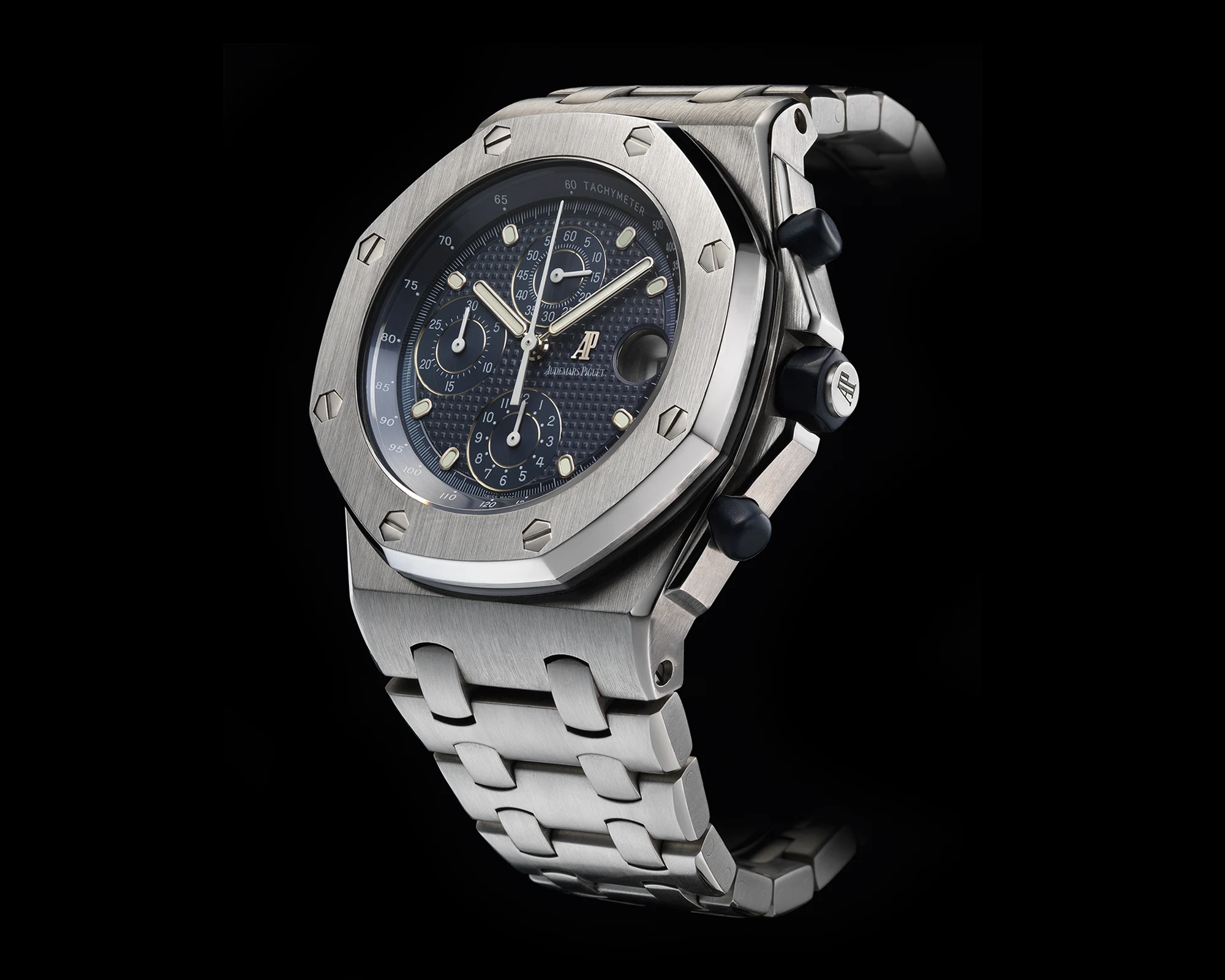
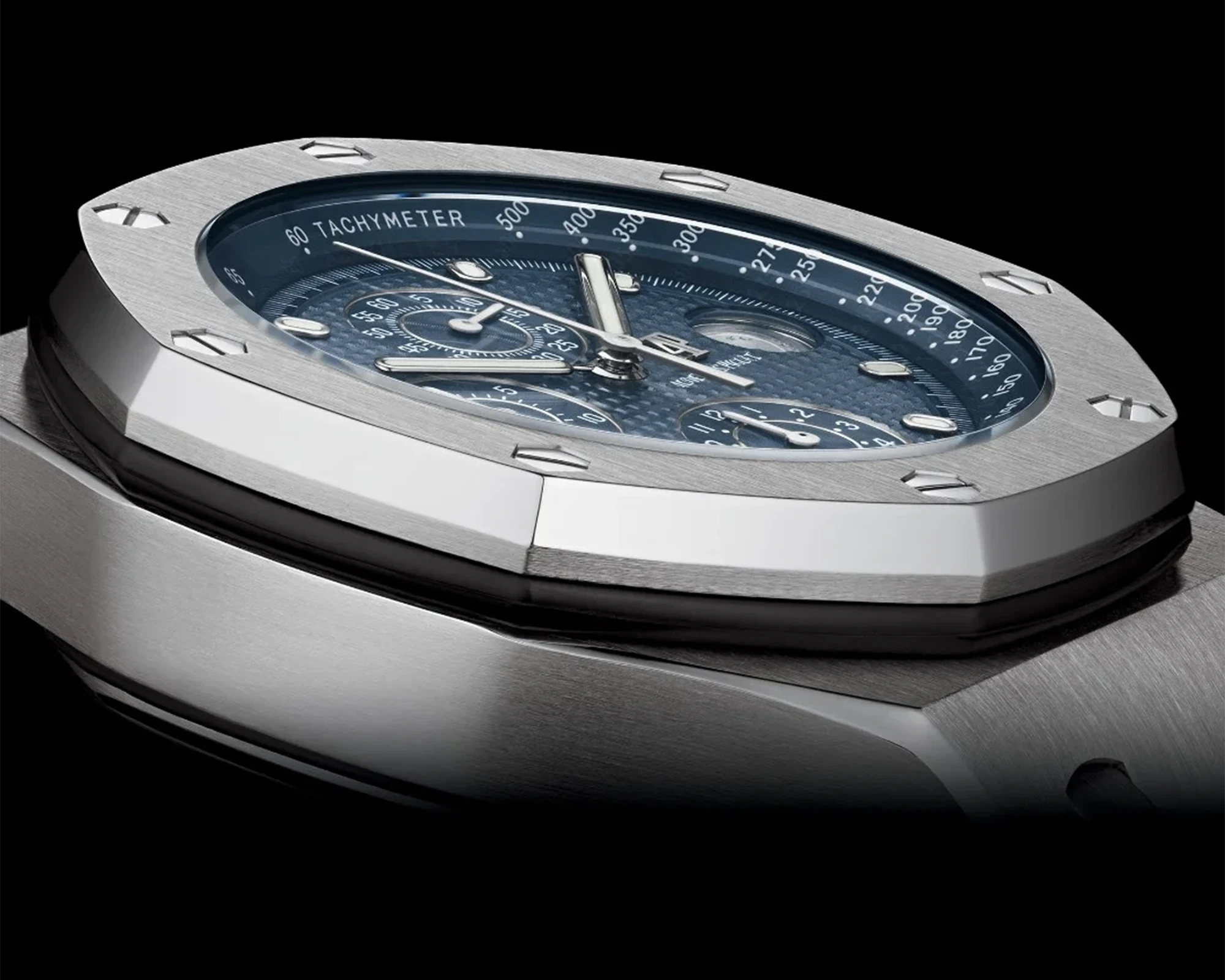
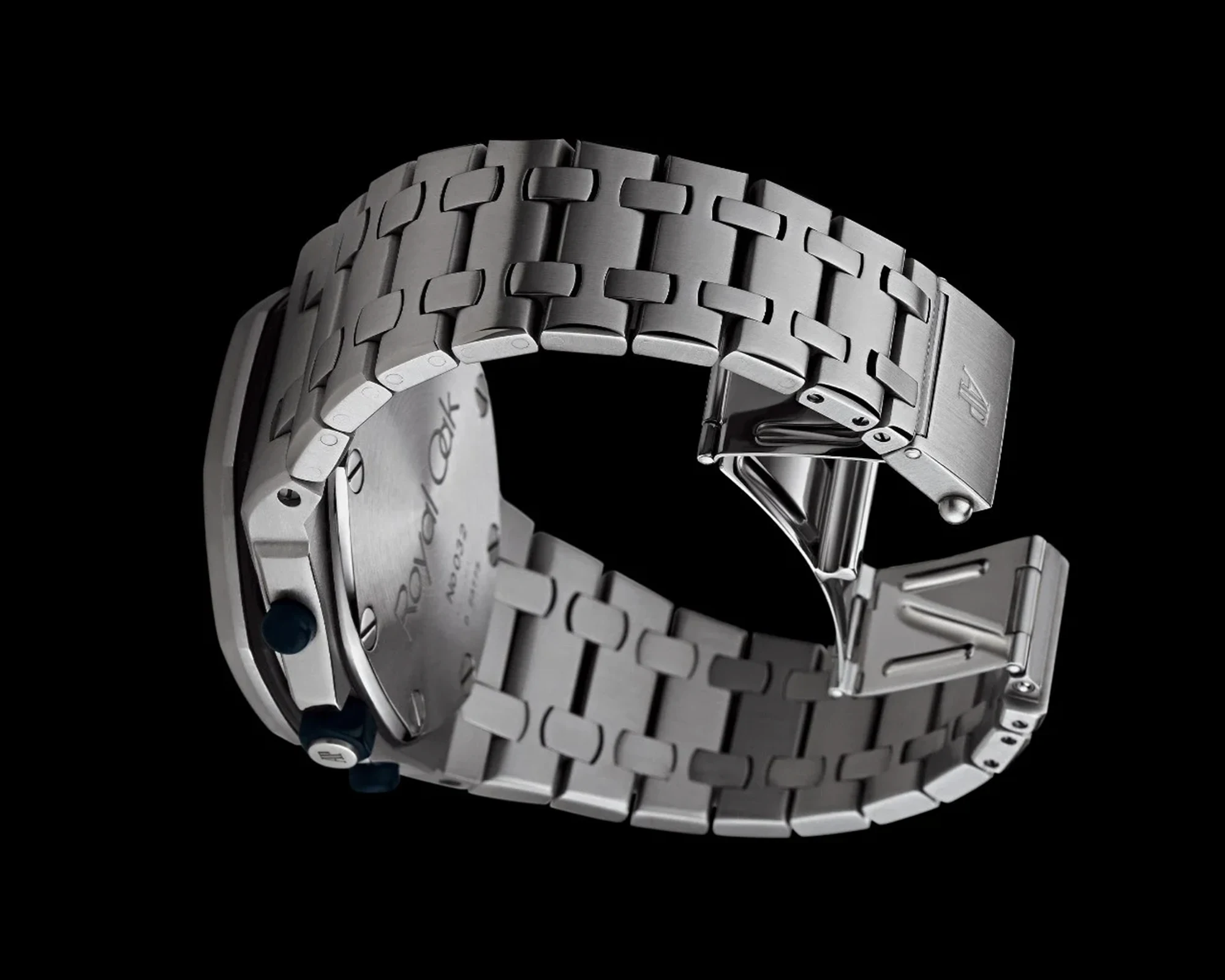
The word ‘Offshore’ was initially not to be found on any of the first 100 models, as the company wanted to save the name for another project if the Offshore was not successful in this version. In addition, the Offshore only sold 61 units in 1993, which could have been attributed to demand, but also to initial and ongoing production difficulties. However, young Italians in particular, who liked the model with its imposing style, got it out of its slump. They contributed to the Offshore’s veritable surplus demand, leading to a petering in the supply of watches available on the market.
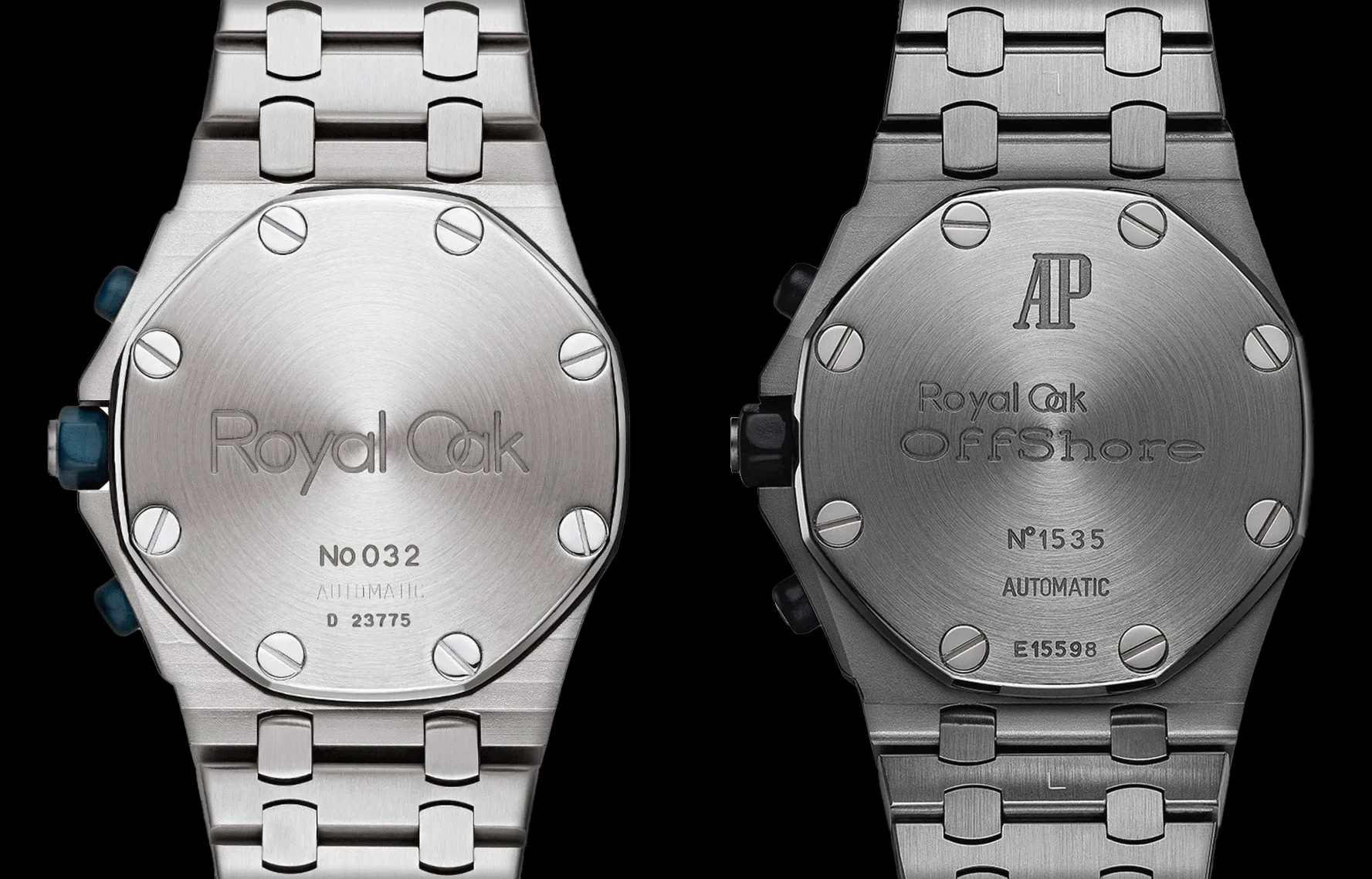
The Offshore was now beginning its success story and Audemars Piguet, aware of the demand, began to launch the reference 25770ST in 1996. Not only was it the first Offshore to appear with a leather strap, but with eight different colour variations, it was also the first step towards transforming the Offshore from an oversized steel watch into a fashionable status symbol. The same year also saw the launch of the first all-gold Offshore, the Ref. 25721BA, which was nicknamed ‘The Beauty’.
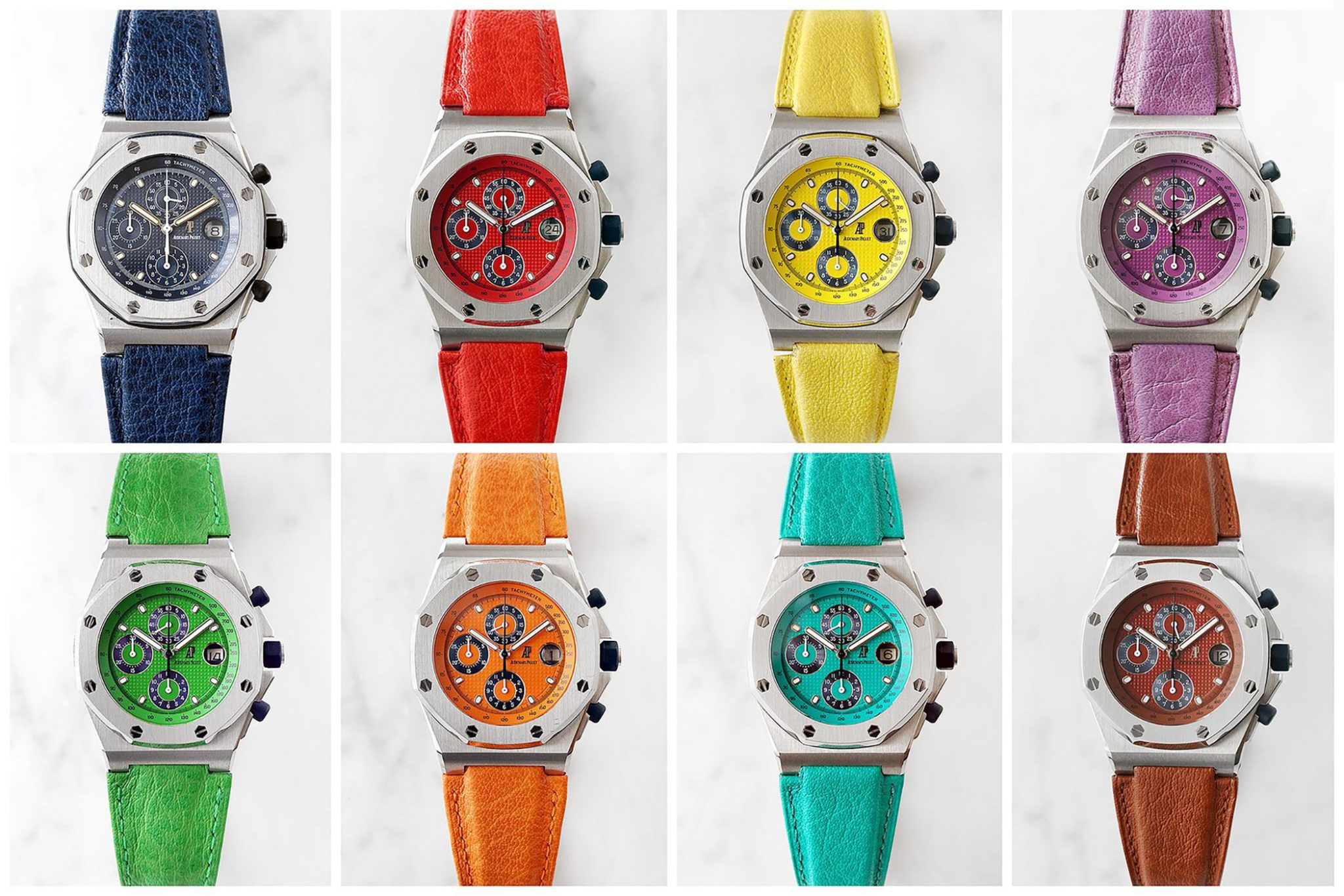
Fotocredit © phillips.com
1996: Triple Calendar
In 1996, Audemars Piguet merged the Royal Oak Offshore with a triple calendar for the first time with the reference 25808ST to create a particularly beautiful model. Behind the octagonal bezel, whose shape and transition to the case as well as the use of hexagonal screws are said to have been inspired by an old diving helmet, was a calendar that displayed the day, date, and month on the ‘Petite Tapisserie’ dial.
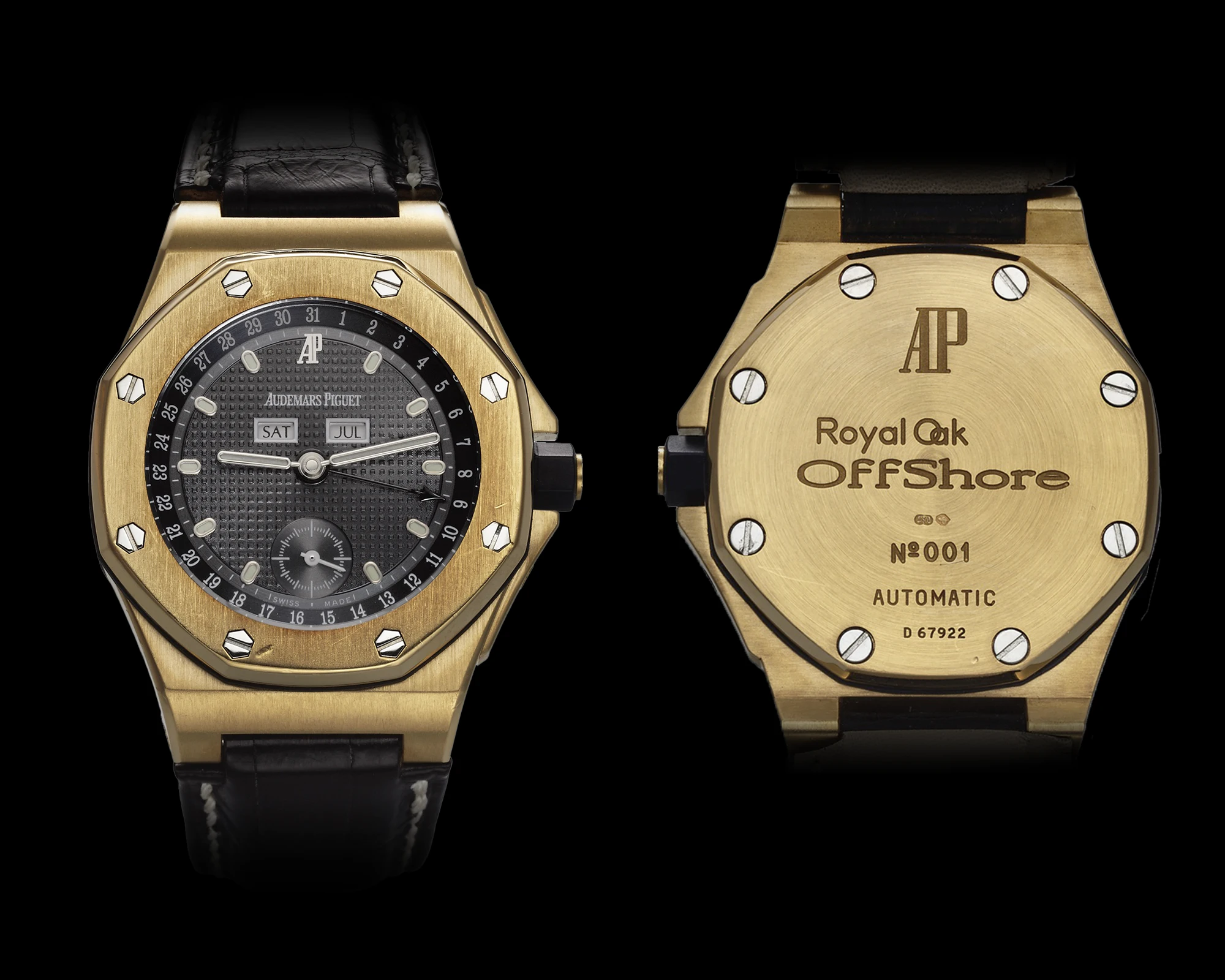
The Royal Oak Offshore Complete Calendar 25808 No. 1., sold in
the United Kingdom in February 1997.
1997: Perpetual Calendar
The first Royal Oak Offshore Perpetual Calendar (Ref. 25854BC) was launched to mark the Royal Oak’s 25th anniversary. It was the first time that Audemars Piguet combined the powerful case, featuring the Offshore’s sporty character, with the highly complex and perhaps most prestigious complication that the mechanical watch world has to offer: the perpetual calendar. The first perpetual calendar version of the ‘Beast’, which was presented in a white-gold case, was followed by models in stainless steel, rose gold and finally titanium.
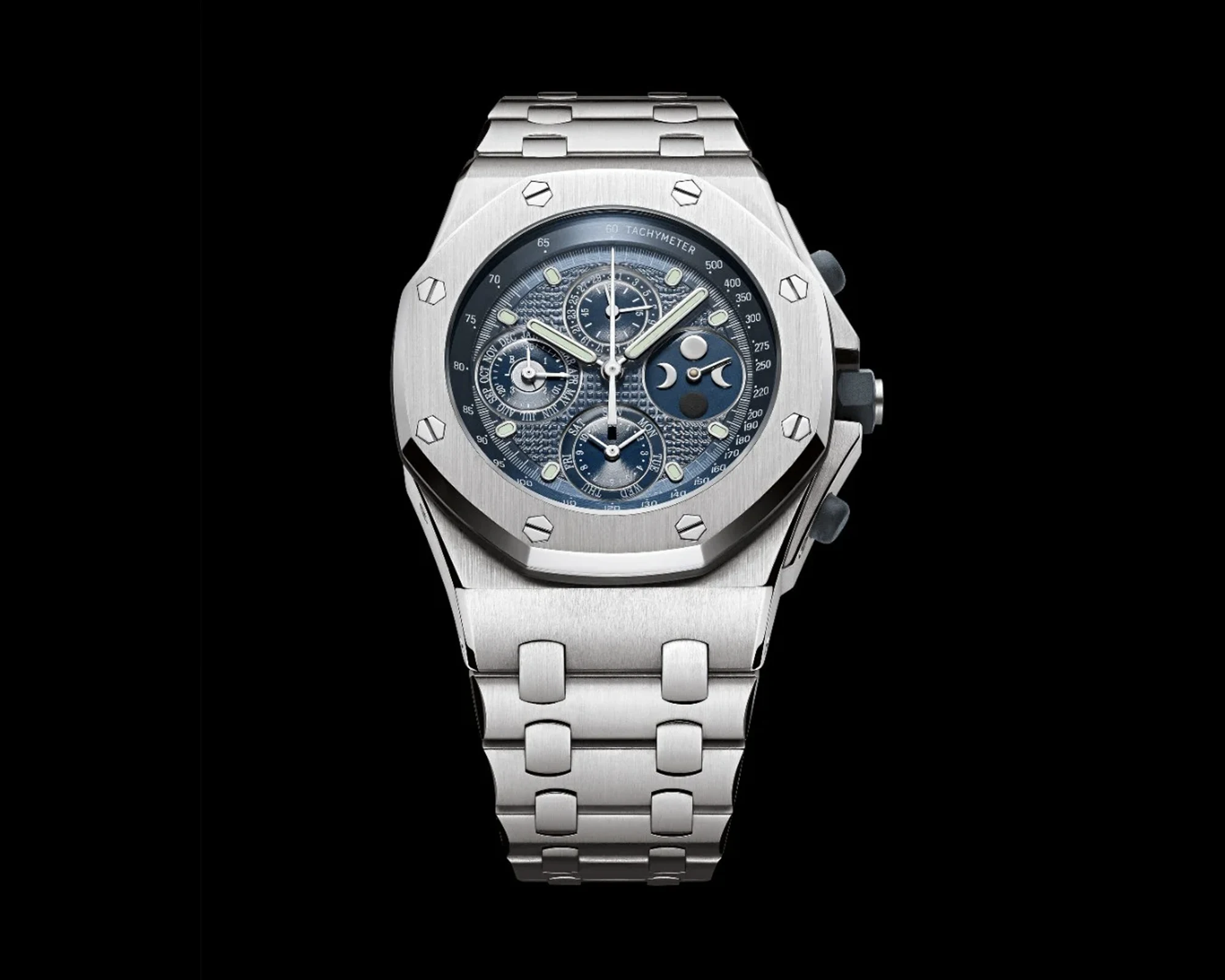
The Royal Oak Offshore Perpetual Calendar Ref. 25854ST around 1997
A particularly beautiful version of the Royal Oak Offshore Perpetual Calendar from around 2005 is the reference 25854TI.00.1150TI. Its hexagonal screws made of polished stainless steel frame a grey dial with a ‘Petite Tapisserie’ pattern – and not the later ‘Mega Tapisserie’ pattern – as well as a grey, brushed rehaut. The black oxidised hands and indices, which are all filled with Superluminova luminescent material, are the most remarkable feature of this watch. The luminous material does not appear in its pure form, but has been modified to take on a turquoise colour. The special luminescent colour in combination with the black hands and grey dial elements creates a high-contrast dial that is not only aesthetically pleasing but also easy to read.

Ref. 25854TI.00.1150TI, ca. 2005
However, it’s not just about the colours, but also about the complications – and there are plenty of them here. The calibre 2226/2839 combines a perpetual calendar with a chronograph that has a power reserve of 38 hours. Another special feature of this model lies in its structure: the gasket ring under the bezel, which is nothing more than a fine line in the Royal Oak, becomes a significantly accentuated gasket ring typical of the collection in the Offshore. Amongst other things, it helps the watch withstand water pressure of up to 100 metres – a true sports watch.
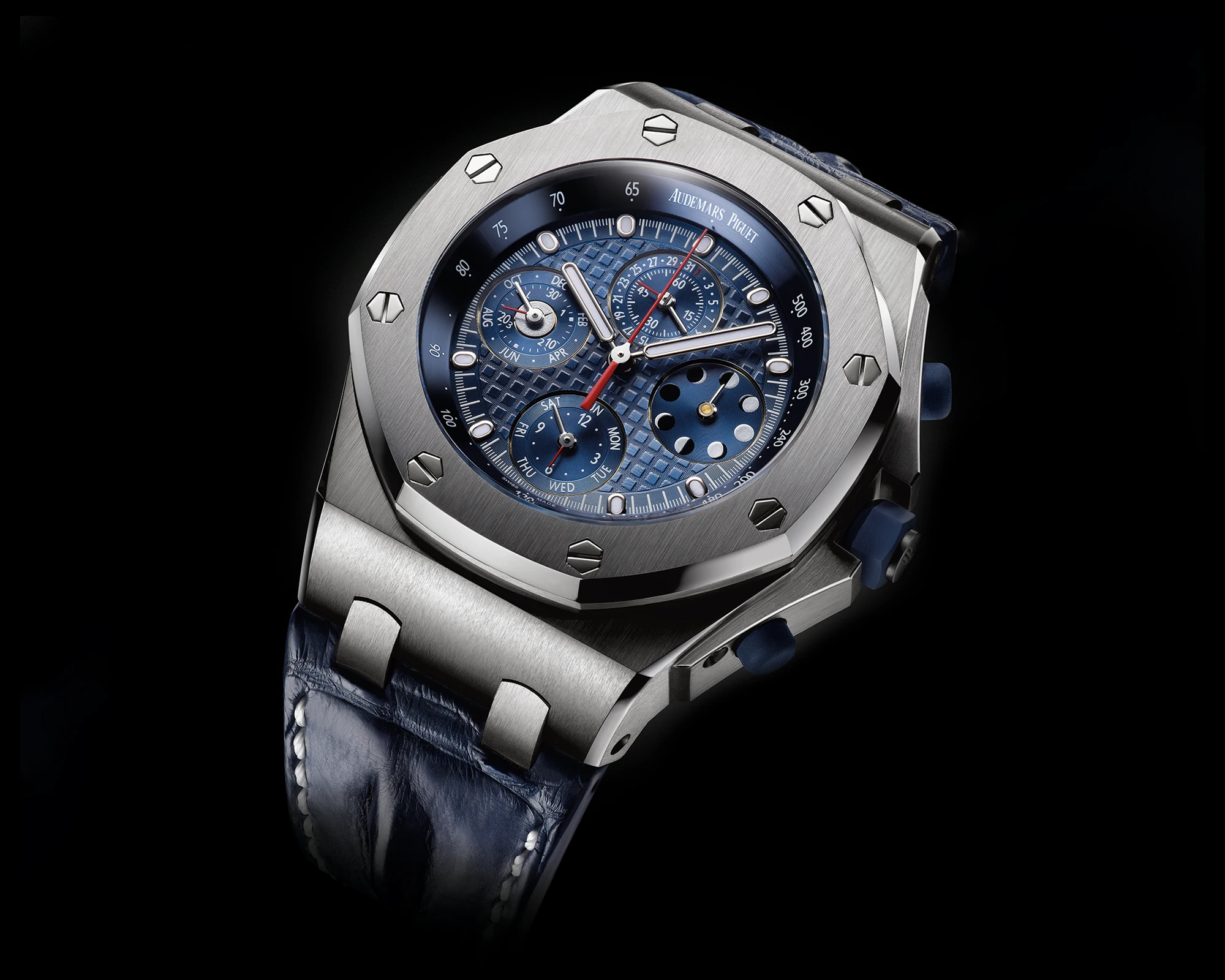
A rare version of the perpetual calendar: Ref. 26209PT.OO.D305CR.01 from 2013, limited to 10 pieces
2005: Royal Oak Offshore ‘Safari’
In 2005, the Royal Oak Offshore ‘Safari’ was added to the collection and popularised the ‘Themes’ series within the collection. Furthermore, at the time of its launch, it was the only watch in the Offshore collection that was equipped with a crocodile strap with a horn back, making it one of the most iconic Offshore references and a collector’s favourite. The ‘Safari’ was named after its beige or ivory-coloured dial with a ‘Méga Tapisserie’ pattern, which has been produced with silver or brown subdial counters over the years and was supposed to give the watch a sporty, adventurous vintage character through its earthy colours.
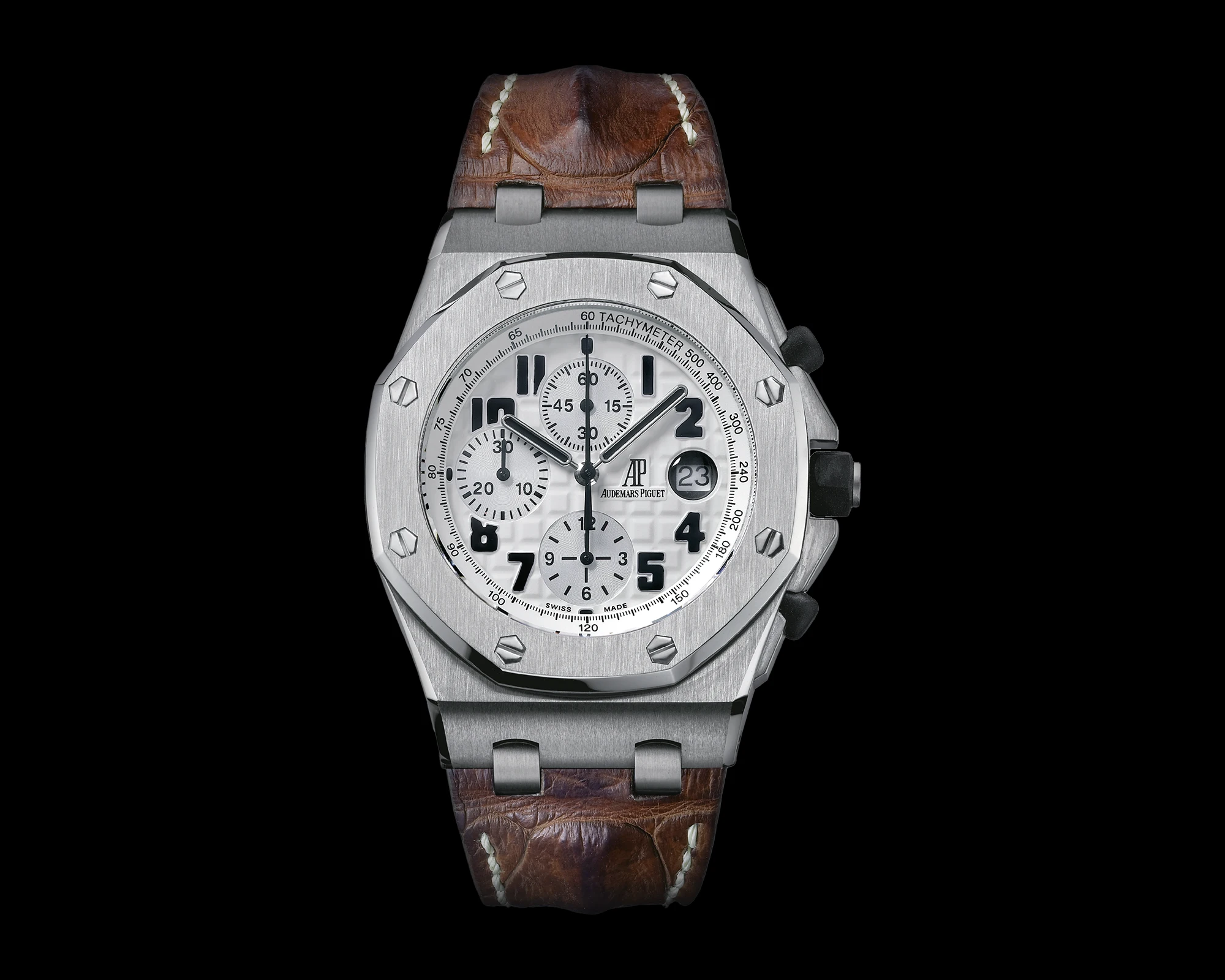
Royal Oak Offshore Safari Ref. 26170ST.OO.D091CR.01 from 2005
2010: Offshore Diver
The story of the Royal Oak Offshore Diver began in 2005, when Audemars Piguet presented the first realisation of the Offshore as a diver’s watch (Ref. 15340ST.OO.D002CA.01) in an exclusive edition of 210 pieces for the retailer Wempe. Five years later, the Diver was added to the product range as an independent line, starting with the Ref. 15703ST.OO.A002CA.01. While the Royal Oak Offshore Diver retained the DNA of its role model, both technical and aesthetic refinements were made to meet the modern requirements of a professional diver’s watch and to enable a water resistance of up to 300 metres.

The Royal Oak Offshore Diver Ref. 15703ST.OO.A002CA.01
The Diver retained the larger case dimensions and rubber elements already familiar from the Offshore, but featured a second crown at 10 o’clock to control the rotating inner bezel. In 2016, a chronograph version of the Diver was also added to the product line. Since then, the Diver has been launched in ever new variations: lime green versions (Ref. 15710ST.OO.A038CA.01) or beige dials can be found as well as white gold, ceramic or carbon fibre cases (Ref. 15706AU.OO.A002CA.01).

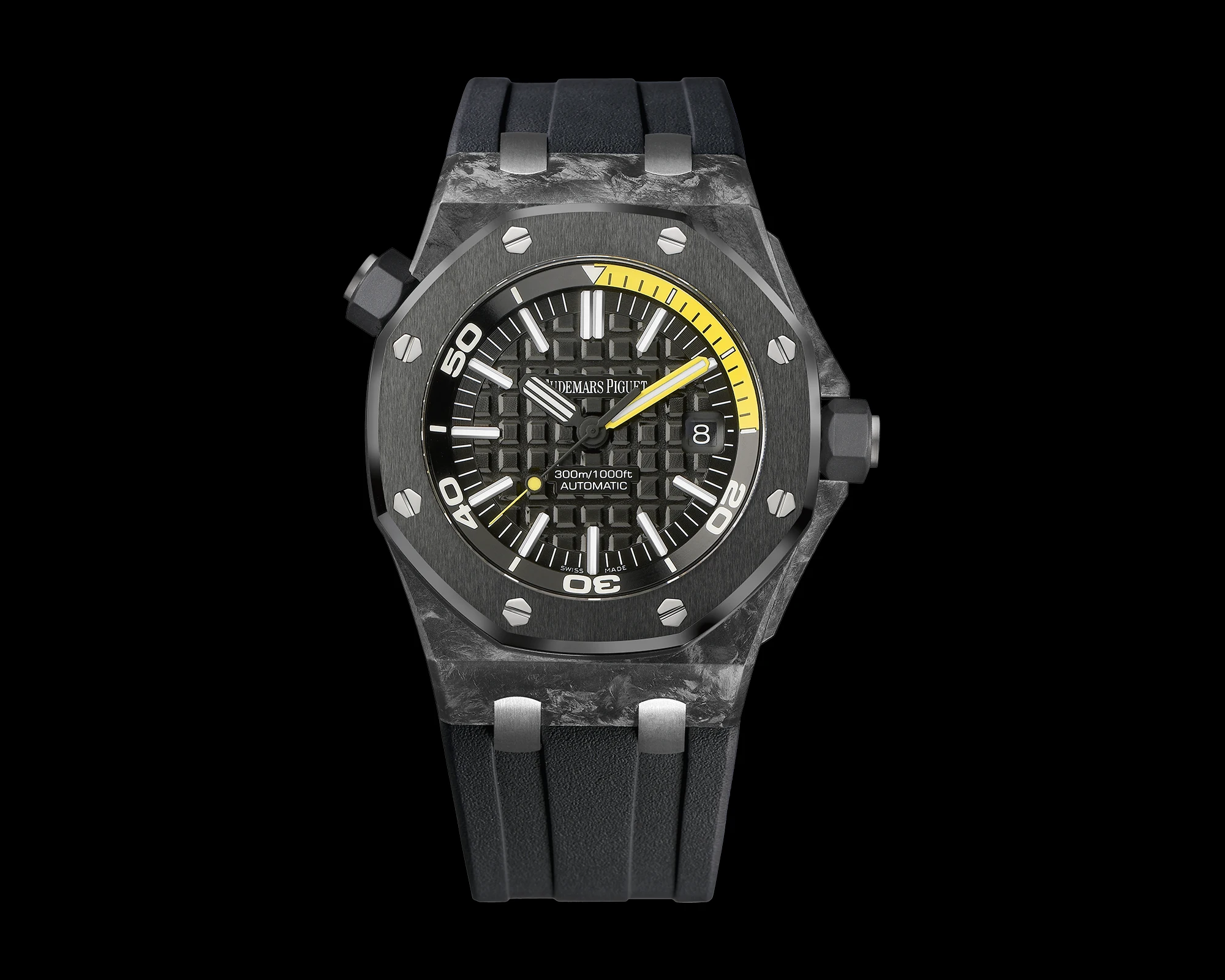
Ref. 15710ST.OO.A038CA.01 and Ref. 15706AU.OO.A002CA.01
Audemars Piguet enters pop culture
In 1999, a decisive idea from François-Henry Bennahmias was to have a major impact on the future of the brand. He was the Managing Director of the American market from 1999 to 2012 before becoming interim CEO for a year and taking full responsibility for Audemars Piguet until 2023. What Bennahmias understood better than almost anyone else back in 1999 was how to harness the universality of the iconic octagonal brand mark and, in a clever move, empower collaborators ranging from Formula 1 to hip-hop to incorporate elements that reflected their personality into the design and sometimes even the structure of the watches they shared.
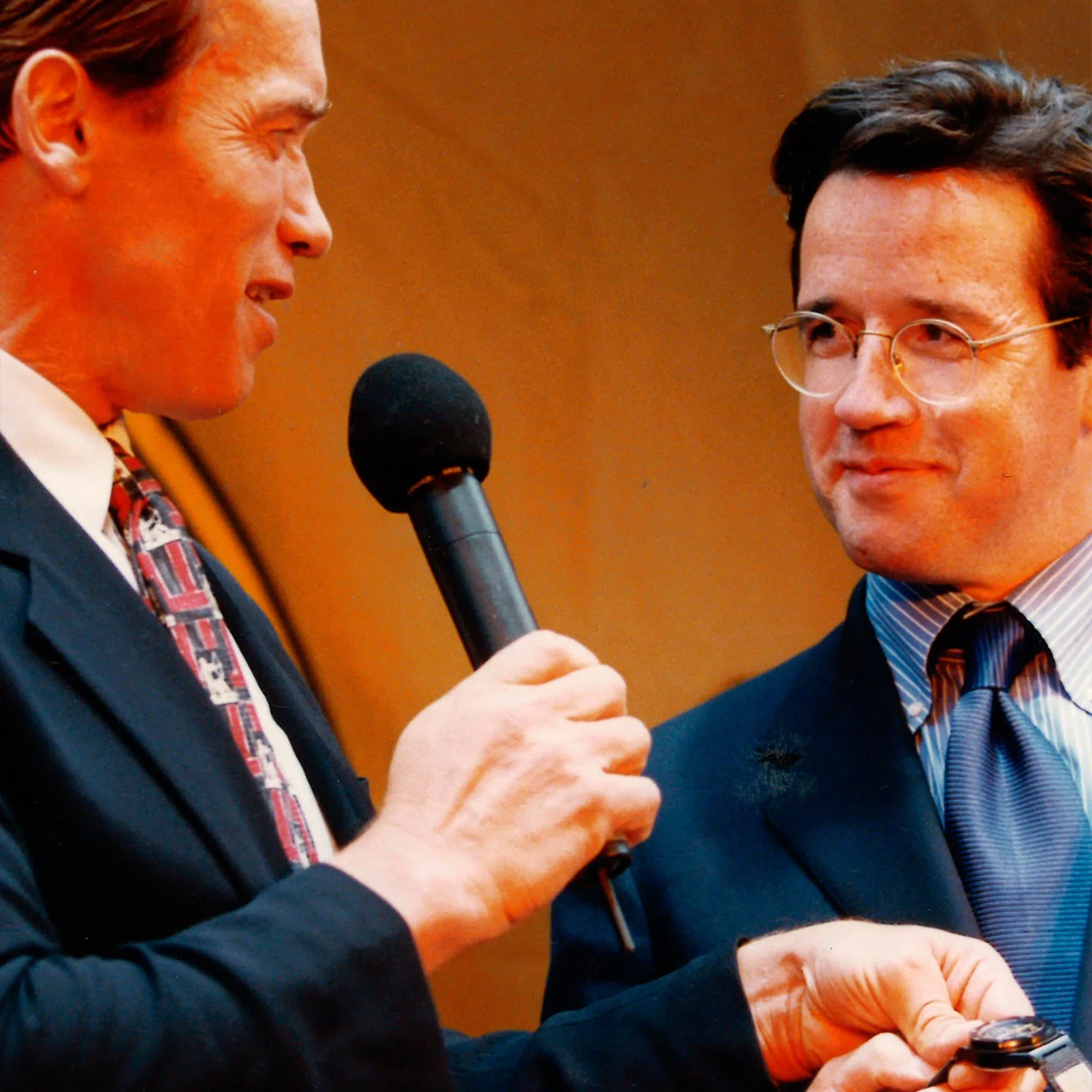
What is common practice today – such as Audemars Piguet’s collaboration with brands like Travis Scott’s Cactus Jack or the presentation of watches with Marvel, where Black Panther or Spider-Man adorn the dial – would have been unimaginable in the 1990s. The most important models created in collaboration with famous personalities are presented below.



1999: Royal Oak Offshore ‘End of Days’ Limited Edition
The Royal Oak Offshore ‘End of Days’ was the first Offshore to be created in collaboration with a famous personality. It was launched as a limited edition of 500 pieces after the release of Arnold Schwarzenegger’s film of the same name in 1999 and heralded a new era. At the same time, the model is the first Offshore with an all-black aesthetic thanks to a PVD treatment. None other than Arnold Schwarzenegger himself was responsible for giving the watch features that embody ‘150% Arnold’ – as François-Henry Bennahmias described it. According to the CEO, Schwarzenegger himself created the design.
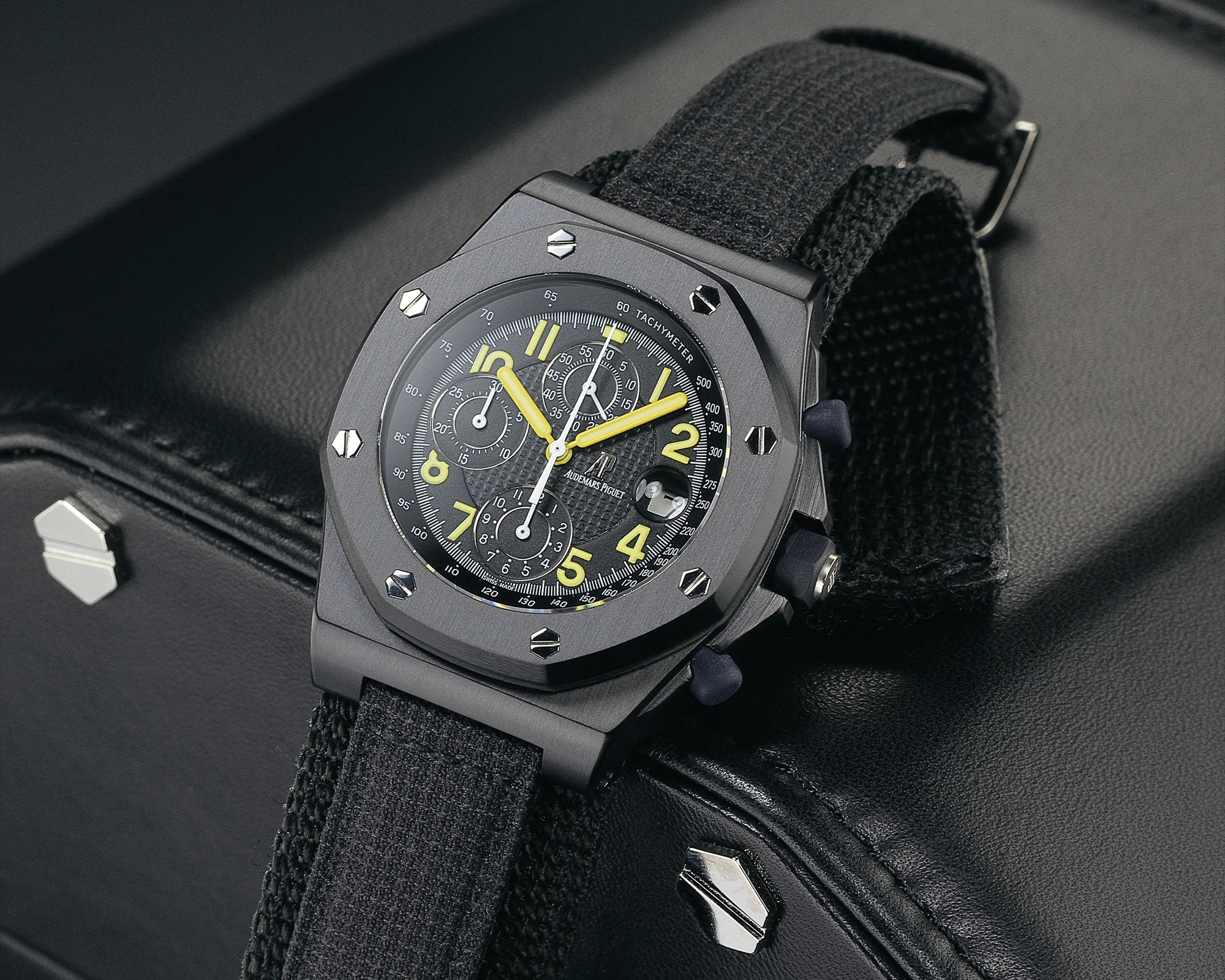
The Royal Oak Offshore ‘End of Days’ Limited Edition
However, the aesthetic that can be seen on the case is also continued on the dial. The date display and the chronograph subdial counters frame an inner ring made of ‘petite tapisserie’, whose black aesthetic is in turn broken up by luminous yellow Arabic numerals. With collaborations like this, which also popularised the brand internationally, Audemars Piguet entered pop culture, and the Offshore was instrumental in this – something that nobody in Switzerland would have believed just a few years earlier.
2002: Royal Oak Offshore ‘Jay-Z 10th Anniversary’
In 2002, something unusual happened: the rapper Jay-Z mentioned Audemars Piguet in his song ‘Show You How’ with the words: ‘Audemars Piguet with the alligator strap…’. It was the first time that a watch brand had been mentioned in this way, and it set off a trend that continues to this day.
Rappers such as Lil Wayne, Drake and Rick Ross capitalised on this trend by name-dropping the brand and its watches in their lyrics to increase their prestige and credibility in the rap community. Rappers who wore Audemars Piguet watches in their music videos stylised the timepieces as a ticket to an exclusive circle and at the same time increased the desirability of those who were not yet part of it. Thus, in hip-hop culture, where success is often expressed through material symbols, AP watches became proof of a lifestyle that the artist wanted to portray and, for the audience, an object that symbolised ambition and the desire for social advancement.
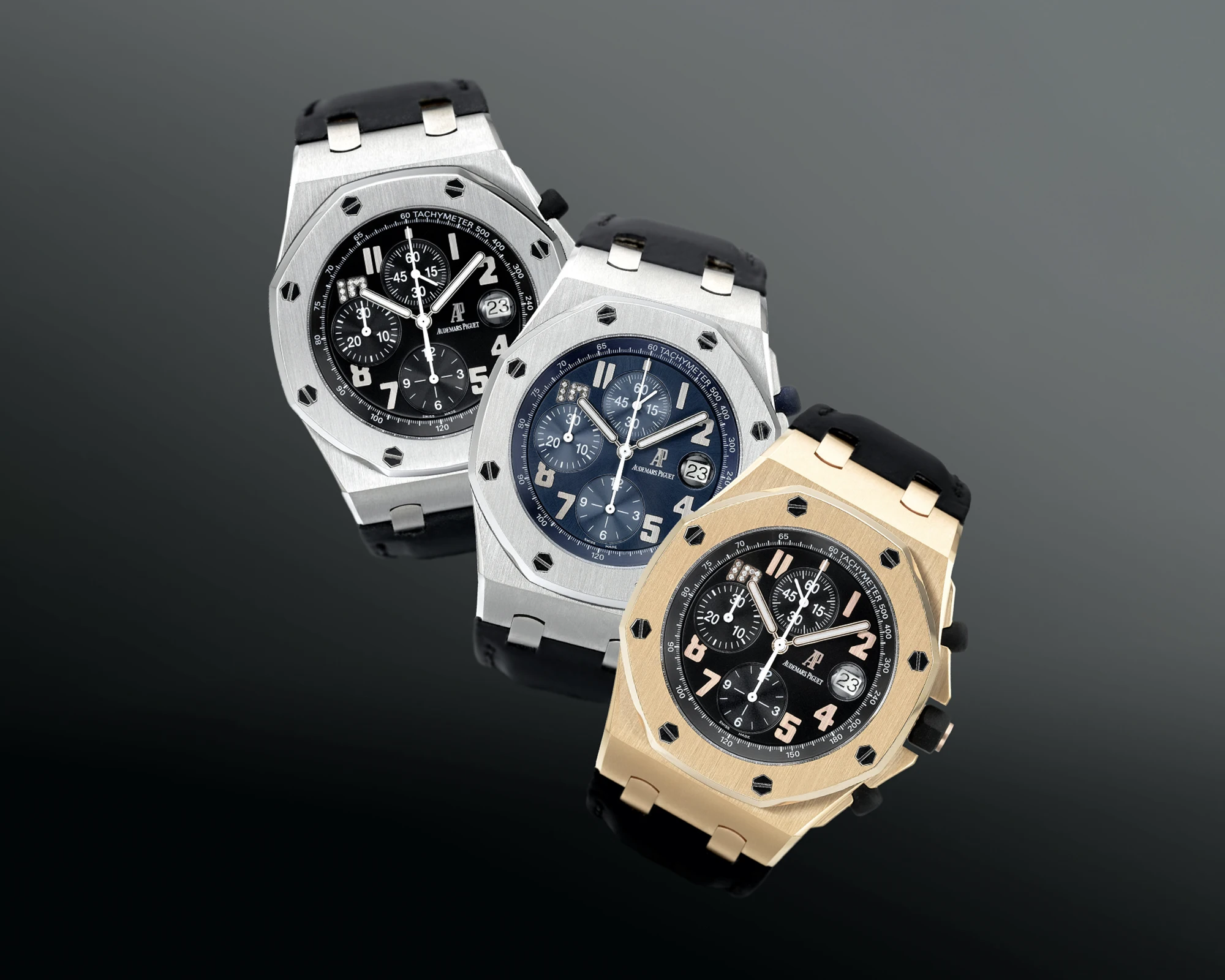
This is thanks to François-Henry Bennahmias, who invited Jay-Z – then still an aspiring rapper – to the brand’s New York office in 2001 to present him with the latest models, including the Royal Oak Offshore. Jay-Z, who already owned 14 AP watches at the time, was thrilled and initially came up with the idea of launching a watch on the market as a joint collaboration. In 2005, to celebrate the 10th anniversary of Jay-Z’s record label Roc-a-Fella Records, the time had finally come: the two collaboration partners presented the Jay-Z 10th Anniversary Royal Oak Offshore, limited to 100 pieces, the first watch to be created in collaboration with a rapper. Each piece features a diamond-set ‘10’ on the dial and the case backs are signed ‘JAY-Z 10TH ANNIVERSARY’. Today, the watch is a true time capsule, as its presentation box contains a 40GB iPod loaded with Jay-Z’s entire discography at the time.
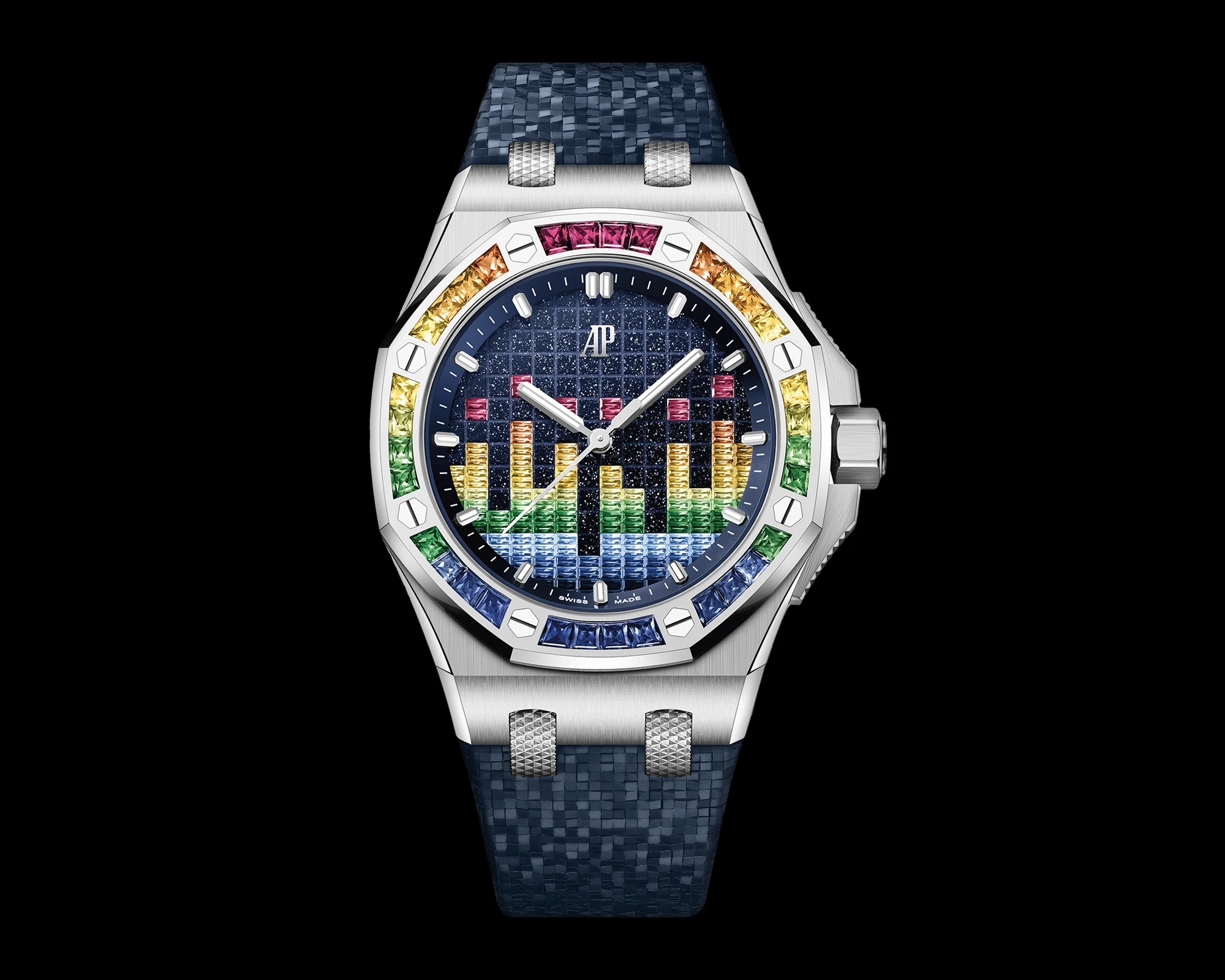
The Royal Oak Offshore Music Edition Ref. 77601BC.YY.D343CA.01
In 2022, the brand paid tribute to its links with the world of music with a special model: the Royal Oak Music Edition presented dials with tapisserie motifs inspired by an equaliser of the kind found in recording studios.
2003: Royal Oak Offshore ‘T3’
Let’s turn the clock back to 2003: people didn’t have smartphones yet, they had Nokias to text each other. 50 Cent was dominating the charts with his song ‘In Da Club’ and ‘Terminator 3: Rebellion of the Machines’ debuted in cinemas a whole 12 years after ‘Terminator 2’. Arnold Schwarzenegger, who had been elected Governor of California and was now more interested in politics than the big screen, played the Terminator once again. As a result, Audemars Piguet, together with Audemars Piguet ambassador Schwarzenegger, launched a limited-edition Offshore of 1,000 pieces, which was huge even by the massive standards of the Offshore collection.

The Royal Oak Offshore „T3“ Arnold Schwarzenegger
At its core, the case is in typical Offshore style, and everything you would expect from a watch in the collection at first glance: from the pronounced bezel to the combination of polished bevels and satin-finished surfaces. But the sheer size of the Royal Oak Offshore T3, with a 48.50 mm titanium case that was mainly reserved for the special editions for Arnold and Shaquille O’Neal, makes even the 44 mm cases that were introduced to the Offshore line in 2011 look small. The watch is also equipped with an oversized crown guard, which also protects the chronograph pushers and emphasises its robust image.
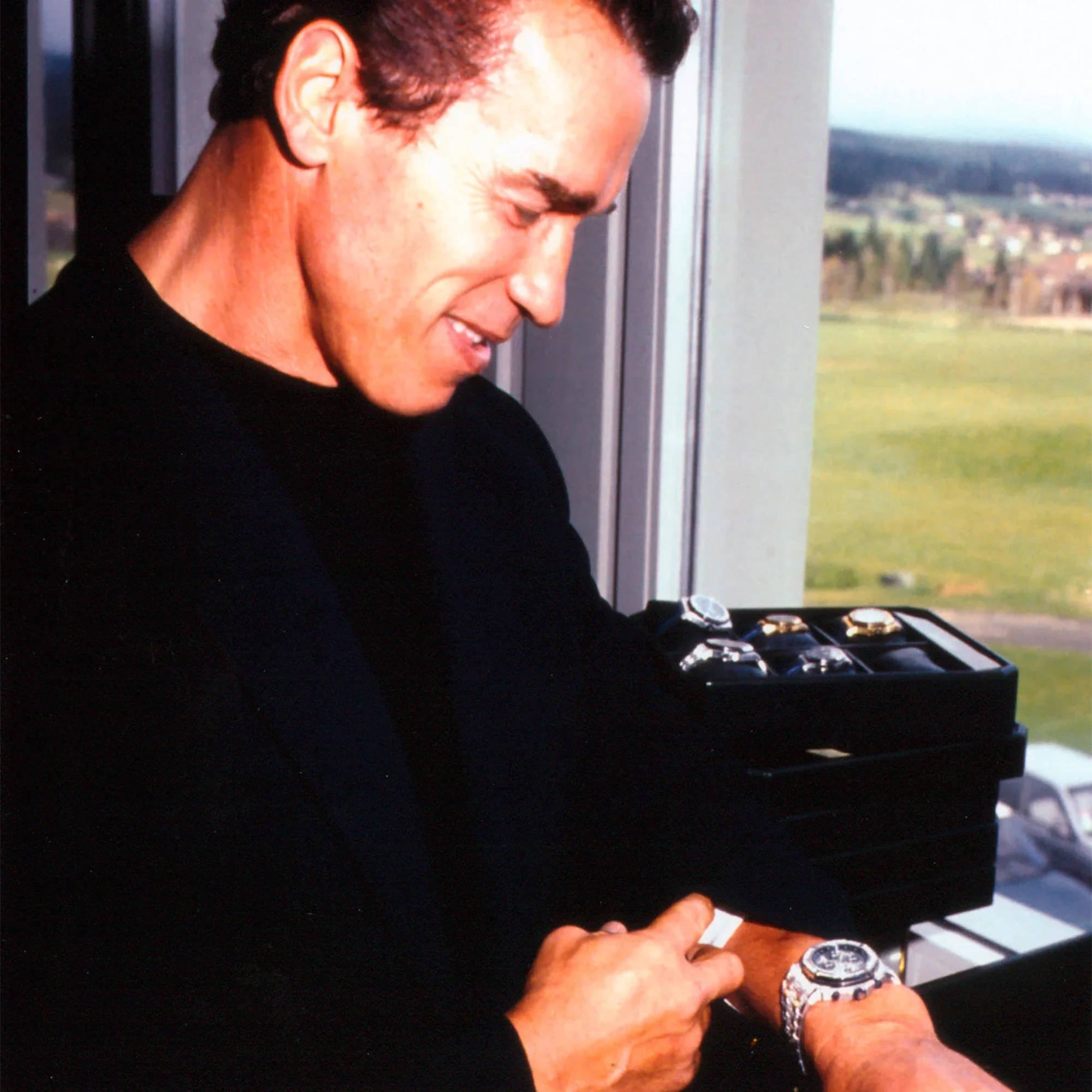
2012: Royal Oak Offshore ‘M. Schumacher’
The various collaborations, especially those with Michael Schumacher, revealed another strength of the Royal Oak Offshore design: its versatility. Before Schumacher received his own special edition, models from Juan Pablo Montoya (2004), Rubens Barrichello (2005 & 2008) and Jarno Trulli (2010) preceded this project.
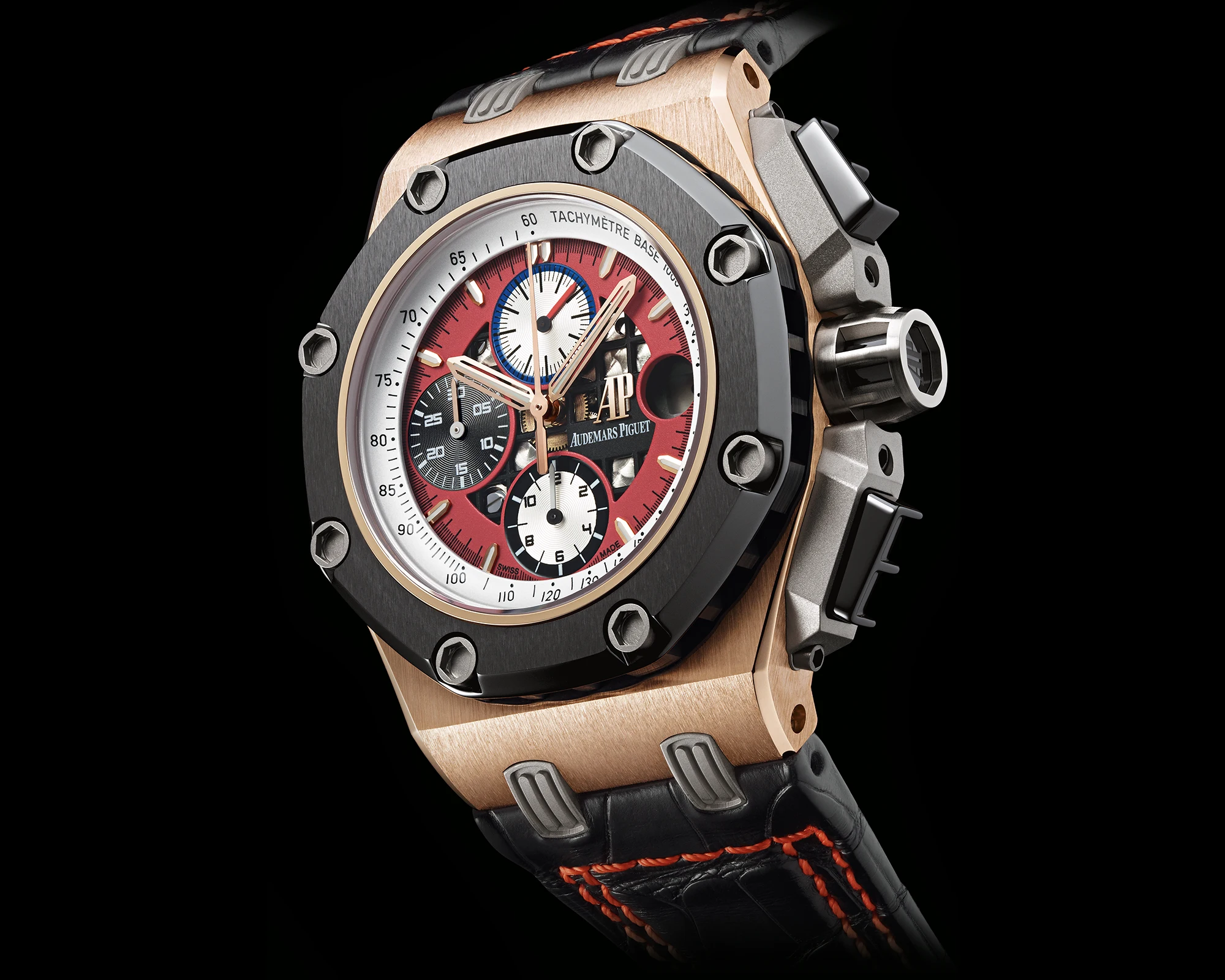
The Royal Oak Offshore Rubens Barrichello III Ref. 26284RO
So what did a man who is considered one of the greatest Formula 1 drivers of all time and has been an AP brand ambassador since 2010 get when he wanted to immortalise himself in a watch? The result is a watch that, thanks to a series of motorsport references, is unlike any other Offshore model and is a fusion of Schumacher anecdotes and Audemars Piguet’s prestigious watchmaking expertise.
The bezel with hexagonal bolts reminiscent of wheel nuts and the pushers on the side of the case, which are reminiscent of accelerator pedals, already embody the motorsport influence. But the biggest reference to Schumacher is to be found on the dial. With 7 world championship titles, a record he holds together with Lewis Hamilton, he has not only left his mark on the history of motorsport, but also on the dial of this watch. It features seven stars: two in blue, reminiscent of his time at Benetton in the 1990s, and five in red, symbolising his dominance at Ferrari in the 2000s.

The Royal Oak Offshore Chronograph Michael Schumacher Limited Edition Ref. 26568PM.OO.A021CA.01 from 2012
The back of the watch also remains true to motorsport. The wheel nuts, which were already to be found on the bezel, are accompanied here by a pattern that is strongly reminiscent of the spokes of a motorsport wheel. These surround an anthracite-coloured galvanised 22-carat gold oscillating weight, on which Schumacher has immortalised himself with his ‘MS’ signature, while bevelled bridges, beaded plates and a Côtes de Genève decoration on the winding bridge lend the movement the glamour of traditional watchmaking.
